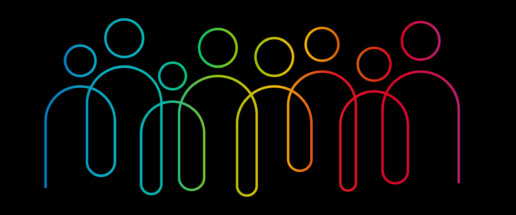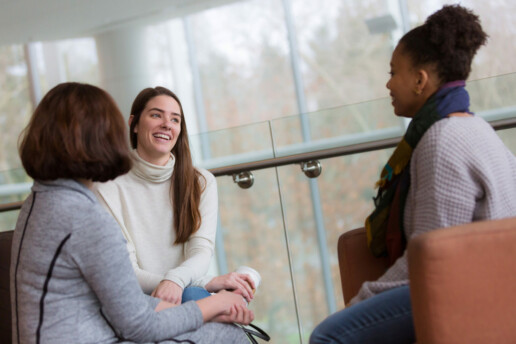Guest Post: Celebrating Asian-Americans: Reflections on Solidarity and Success in the Sunlight
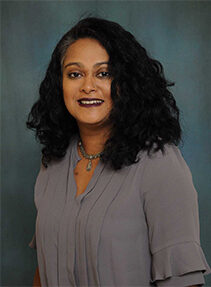
Cyra Akila Choudhury
Professor of Law
FIU College of Law
Center for Law and Digital Technologies, Leiden University
Asian Americans have been in the news a great deal in the last several years. This year has been the year for Asians in the movies. Over the pandemic years, Asians and Asian Americans were in the news regularly for being victims of racial harassment and violence. That violence reached its extreme in the Atlanta massacre of six Korean American women working at a spa. The brief outpouring of support and solidarity after the shootings were welcome but not sustained. Within months, Asians went back to being a marginal minority group.
Even though we are the fastest growing minority, too often, we are only given attention in extraordinary moments: when we are the agents (Oscar winners, school shooters) or objects (victims of violence) of spectacular events. The most recent sustained attention given to Asian Americans has been in the context of the legal attacks on affirmative action.[1]
As Asians, we occupy the spotlight but not the sunlight, solidarity ebbs and flows, and our excellence is a double-edged sword. In this blog post, I reflect on the ways in which we have become agents for change in ways that overcome the binary glare of the spotlight or dark of its shadow. Asians have practiced and should continue to commit to radical solidarity both among ourselves and with other groups even as we unapologetically embrace our excellence. I offer these reflections as part of an ongoing conversation about what it means to be Asian American—an umbrella that includes a diverse group of people—in this moment.
- Seeking the sunlight not the spotlight
We are used to not being seen and not attracting attention to ourselves. Psychologist Jenny T. Wang writes in Permission to Come Home: Reclaiming Mental Health as Asian Americans,[2] that safety was one of the primary needs of her immigrant family. Safety meant following the plan of achieving stability and success without fuss. Often this means that we keep our heads down and get the job done, sacrificing what we truly love for the sake of duty. The light is shone on us by others when they perceive something worthy of notice.
In short, unless we are winning Oscars, running Google, or being massacred, people really don’t notice Asians. This is the spotlight effect. An external gaze that lights us up temporarily. As law students and lawyers, this might happen when we win an award or a big case. But what about when we’re not winning something? Asians deserve the sunlight and not the spotlight. That is to say, rather than being content with attention primarily when we achieve excellence, we deserve to be visible and present just as we are. Living in the sunlight also means being willing to be seen in our various workplaces and in society. Raising our hand in class, speaking in our own voice, running for public office, applying for promotion, and owning our histories and accomplishments.
- Practicing radical solidarity
Asia is a vast geography with ancient civilizations. “Asian” is not a race, a cultural group, nor a linguistic group. Asian Americans hailing from different parts of Asia are a diverse group with many sub-diasporas. In legal education, for instance, Asian Americans include those with ancestors from China, Korea, India, the Philippines, Japan, and Vietnam. Increasingly, the shared experiences of these communities in the U.S. based on political marginalization, racism, immigration, and some cultural values have led to a growing sense of shared identity as well.
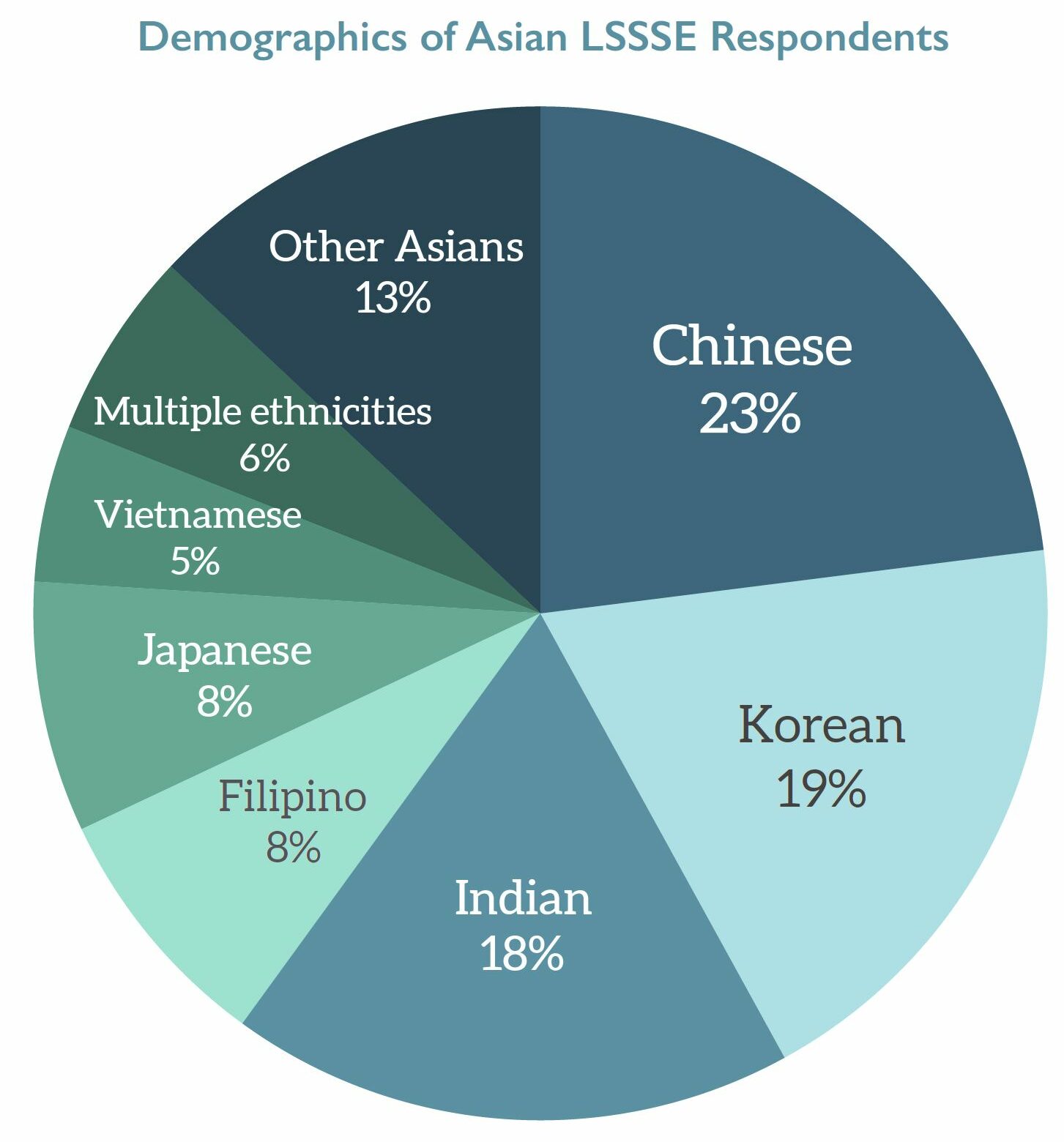 Yet, much more work needs to do be done to forge these nascent bonds. After the Atlanta massacre and the pandemic related violence against East Asian communities, there was a surge of broader recognition that Asian Americans were subjects of racism. This massacre was preceded by the massacre of six Sikhs in Wisconsin in 2012. This too was an Asian massacre and yet, we rarely connect the two as anti-Asian racism. Solidarity among Asians in an increasingly polarized political society has become very important if we want to shape and direct change.
Yet, much more work needs to do be done to forge these nascent bonds. After the Atlanta massacre and the pandemic related violence against East Asian communities, there was a surge of broader recognition that Asian Americans were subjects of racism. This massacre was preceded by the massacre of six Sikhs in Wisconsin in 2012. This too was an Asian massacre and yet, we rarely connect the two as anti-Asian racism. Solidarity among Asians in an increasingly polarized political society has become very important if we want to shape and direct change.
Asians have been partners in all of America’s struggles: the civil rights movement, labor rights, anti-war protests, and resistance to the War on Terror. We have demonstrated our solidarity with other groups, and we must do the same within our Asian communities as well. Radical solidarity, as I define it, means showing up for the struggle when called. When Black communities call for resistance, we show up. When Latinx communities ask for solidarity, we show up. Same for feminists and LGBTQ communities. We cannot succeed meaningfully in isolation. These struggles overlap within our communities. Moreover, radical solidarity is something we do without taking stock. I recall an acquaintance remarking in response to the Atlanta massacre, “I’d like to support Asians Americans, but they call the cops,” This is the opposite of radical solidarity. It is contingent solidarity and as we all know, fair-weather friends are of limited value. No single group has succeeded without radical solidarity from other groups. Without the civil rights movement, many of us would not even be Americans.
For law students, radical solidarity means working with other groups, showing up for their events, collaborating with others. LSSSE data make clear that law students excel at this already, both having serious conversations with students of a different race and working to understand students from different racial backgrounds.
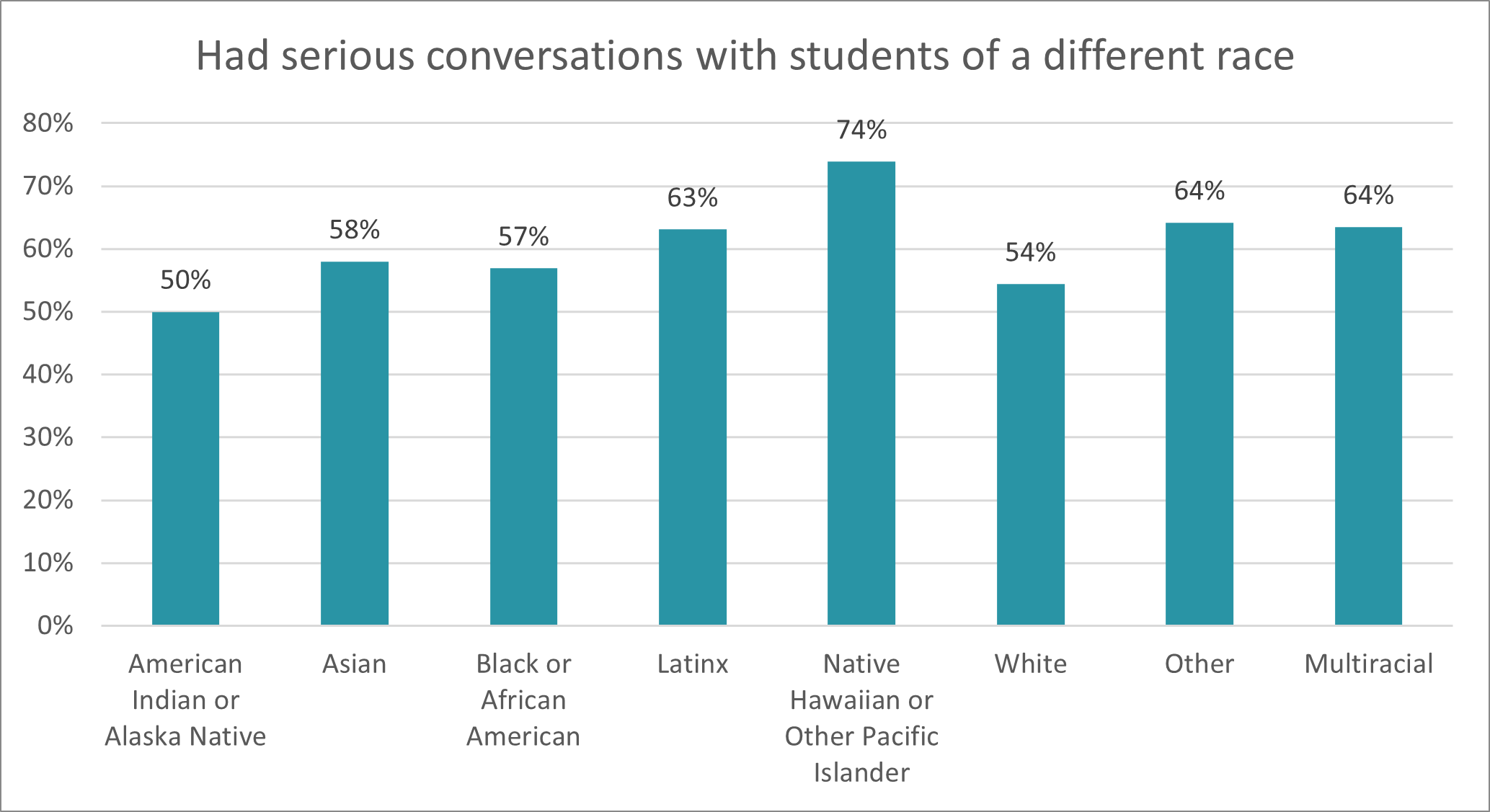
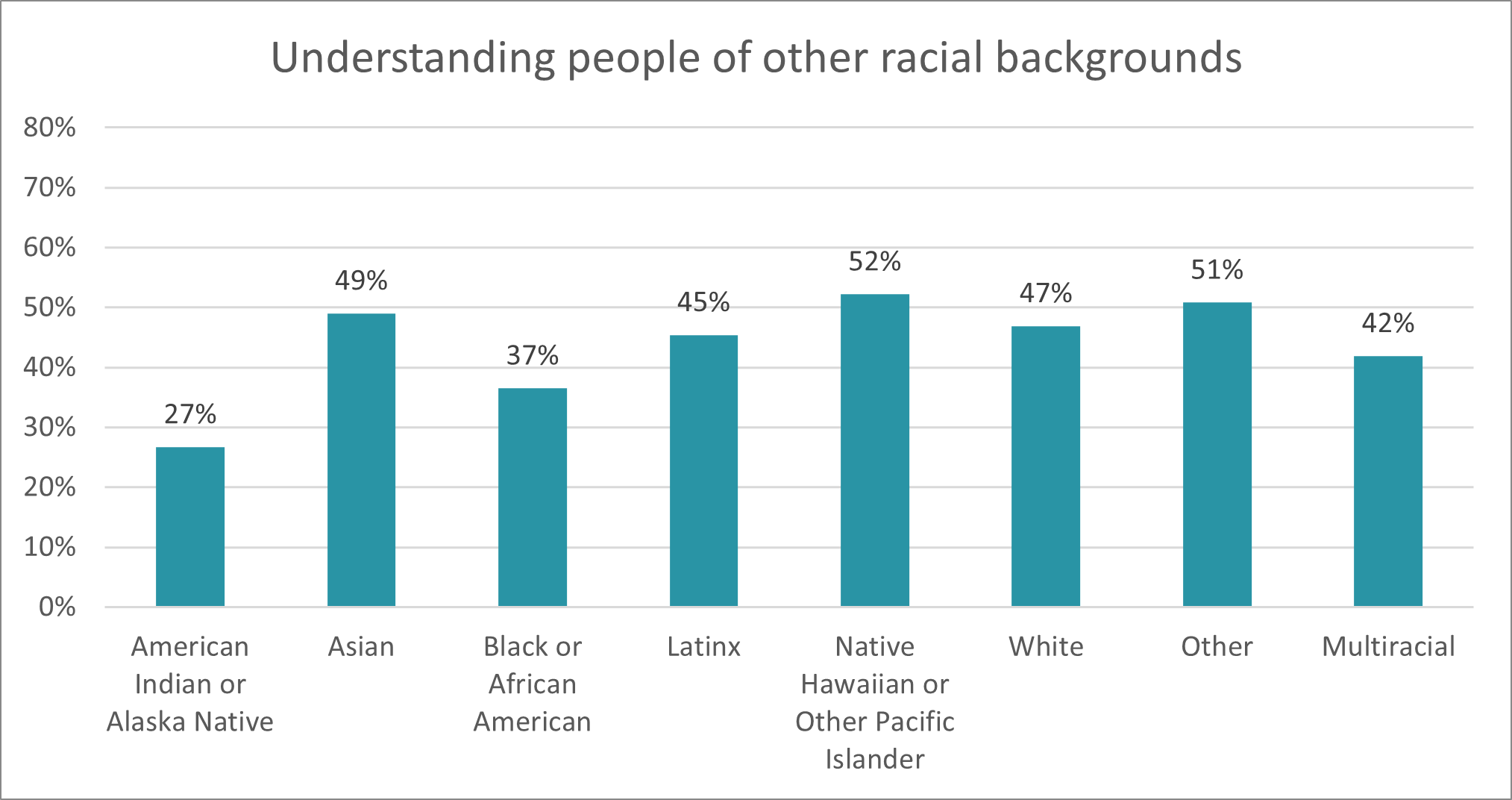
For law professors, it means mentoring across various communities, perhaps reading across histories and cultures, and comparative research. For lawyers, it means building professional bridges and perhaps doing pro bono work for the communities that need it. Radical solidarity might require humility but not apology. I’m sure that there are many in our communities with very different ideas and politics but I speak here to the majority of us who believe in social equality.
- Embracing excellence and failure
Asians Americans are known as the “model minority.” It’s a pernicious myth about exceptionalism that is used to chastise other minority groups. In the last few years, weaponizing Asian excellence to harm other minority groups has been difficult for most Asians because we support affirmative action. How do we celebrate the very excellence that has been used to falsely exceptionalize us? Others have written extensively about the harms of this myth not only to others but to Asians themselves. Here I want to reflect on another consequence: a reluctance to embrace our successes and excellence as a community because it reinforces the myth.
The model minority myth has led to an ambivalence in celebrating our communities’ successes—an obstacle that few other groups have had to overcome. Achieving success because of hard work should be celebrated for itself while understanding that it says nothing about the value and success of any other group. Our radical solidarity with marginalized groups prevents us from claiming any exceptionalism for ourselves. And celebrating Asian Americans who succeed should not be mistaken for it. Nor should it be denigrated as mere borrowing, assimilationism, or white adjacency which is another kind of negative exceptionalism. Other groups’ similar successes are rarely spoken of in these denigrating ways.
So, celebrate the Indian kids who win spelling bees, the Chinese kid who wins the math competition while rejecting that Asians are somehow exceptional at spelling or math! Our stars are just that: stars. We have exceptional talents who deserve to be celebrated.
I want to end on a positive note on what is commonly thought to be a negative experience: failure. One stereotype about Asians is that, in our families and communities, failure is not an option. However, we should embrace failure as part of success rather than as a shameful shortcoming. As a law professor, I tell my students that they should learn from their failures, admit to them, overcome them, and move forward. Failures are inevitable and learning to cope with them without shame is important to the mental health of the community.[3] Asians fail as much as any other group and to deny this is to enforce an unacceptably high standard. To fully lay the model minority myth at rest, we must accept both our success and our failure. Asian belonging is not contingent on group accomplishment or excellence. We deserve the sunlight, to be visible, and fully accepted as Americans when we’re winning as well as when we’re not.
____
[1] Students for Fair Admissions v. Harvard; Students for Fair Admissions v. University of North Carolina
[2] Jenny T. Wang, Ph.D., Permission to Come Home: Reclaiming Mental Health as Asian Americans (2023).
[3] See id.
Guest Post: Suits for Success
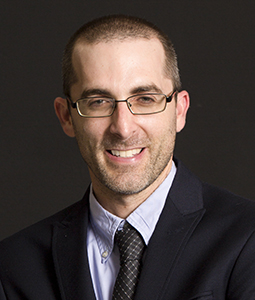
Colin Miller
Professor of Law
University of South Carolina School of Law
In 2018, I saw a tweet thread by attorney Alyssa Leader offering advice to law students on purchasing professional clothes on a budget. The thread was inspired by Leader’s memories of being a 1L and trying to swing a new wardrobe on student loans for job interviews. It led to me recalling my own time as a 1L, when all I had were ill-fitting Dockers and dress shirts, samples from my dad’s job as a Levi’s salesman. Knowing that many of my students faced similar issues, I researched whether any programs existed where job applicants could borrow professional clothes.
I came across the “tiebrary” program at the Paschalville Branch of the Free Library of Philadelphia. In a neighborhood with high rates of poverty, unemployment, and citizens returning from incarceration, the program allows patrons to check out professional clothes for job interviews. Further research revealed that this program was inspired by a similar one at the Queens Public Library, started when a library assistant gathered unused, clear VHS cases to display ties that patrons could check out. Articles on both of these programs sung their praises, with patrons crediting some of their success in the job market to their ability to dress for success.
Having fallen down the rabbit hole, I read studies suggesting that wearing professional clothes not only increases confidence and the chances of being hired, but also thinking and negotiating skills. Given how critical such skills are to success in summer jobs, I thought that a similar program for the students at our law school shouldn’t involve rentals; it should allow them to keep those clothes and wear them while they worked, not merely while they tried to be hired.
And thus, Suits for Success was born. First, we needed a space to house the program. Luckily, my Associate Dean counterpart, Susan Kuo, had started a free pantry for food insecure students. The space was big enough to house not only non-perishable food, but also a few clothing racks, allowing for one-stop shopping. After I took a trip to IKEA, we had all of the infrastructure we needed for the program.

Now, we simply needed to stock the space with suits, skirts, slacks, and other accessories for our clothing insecure students. Therefore, with assistance by my research assistant A.C. Parham, we conducted a month-long clothing drove where students could donate new and gently used professional clothes. We placed receptacles around the school where our students could drop off clothes that could help their classmates land the jobs of their dreams. Many of our students were thrilled at the opportunity to help their fellow students, building a sense of camaraderie around the law school.
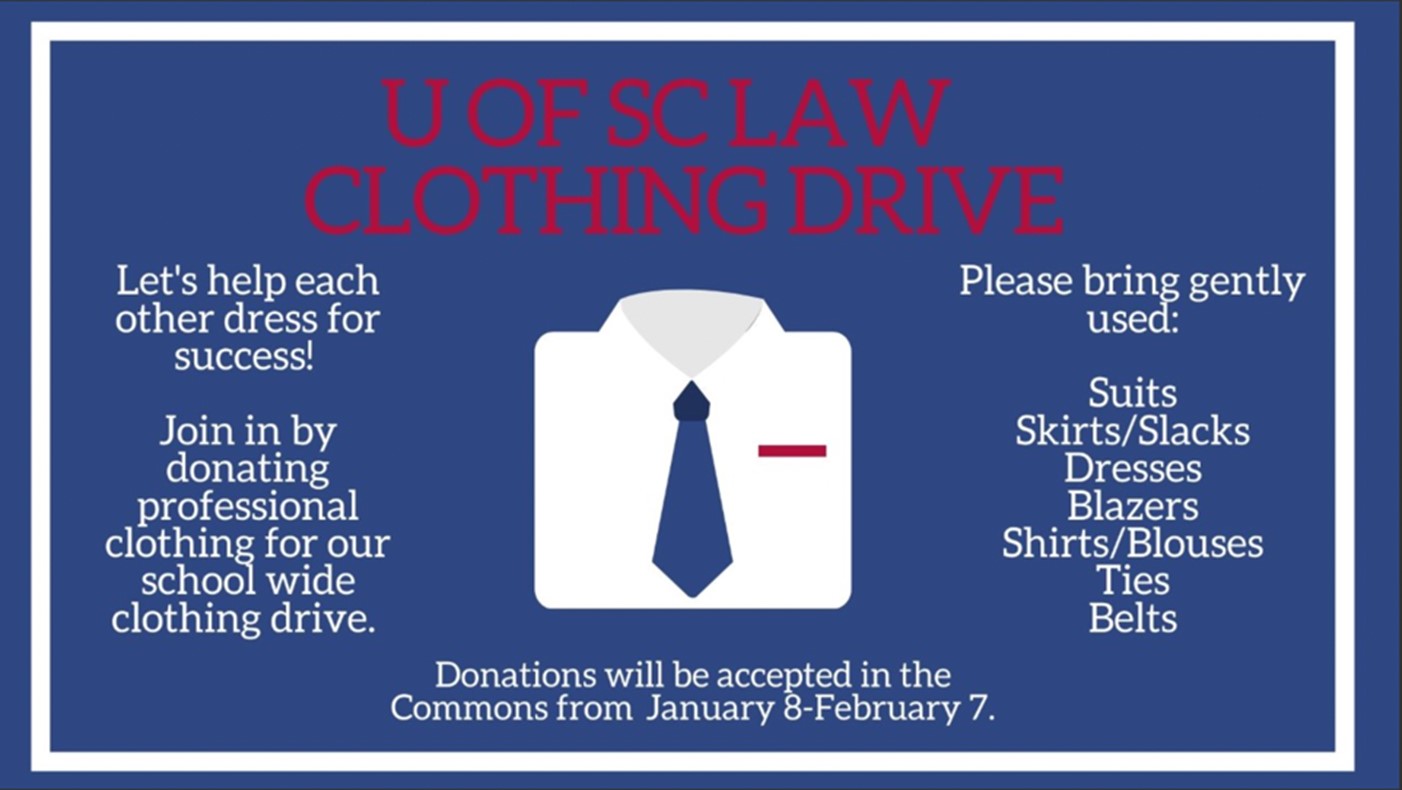
But it went further than that. We promoted Suits for Success on social media, and it led to local lawyers seeing and understanding the need for the program. Soon, we started getting donations from members of the bar, who now better understood the financial issues facing our students and how they are orders of magnitude larger than the ones they faced when they were in school.
These are some of the same issues identified in the LSSSE data, concerns about making ends meet that disproportionately impact women and students of color. For instance, LSSSE data show that first-gen students (those who are the first in their families to attend college and therefore less likely to have professional clothes as hand-me-downs) also have the highest debt levels—leaving little extra money to spend on a new wardrobe. Financial concerns are also a huge source of stress for first-gen students, and many others. Being able to alleviate this in even a small way through Suits for Success is a simple way to support our students.
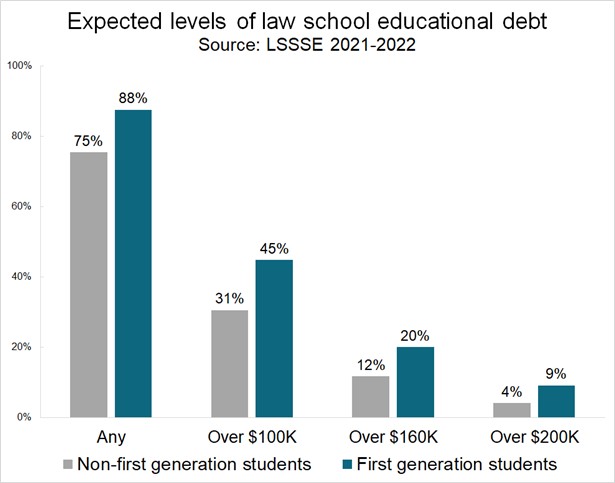
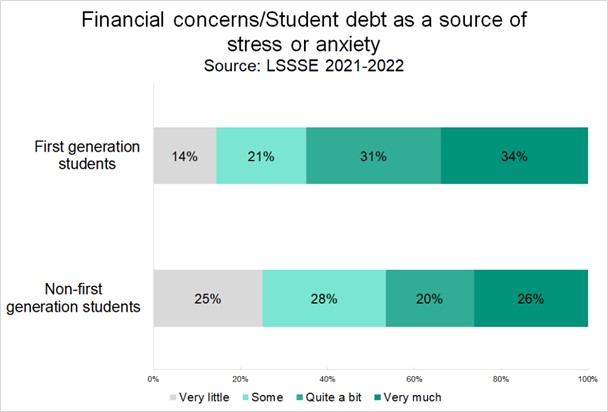
There are, of course, systemic issues that our food pantry and Suits for Success cannot and do not address. But we hope that these programs can at least make the difference at the margins and offer our students some security that they otherwise wouldn’t have.
Better than BIPOC
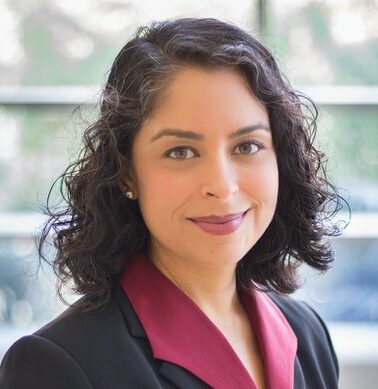 Meera E Deo, JD, PhD
Meera E Deo, JD, PhD
The Honorable Vaino Spencer Professor of Law, Southwestern Law School
Director, Law School Survey of Student Engagement (LSSSE)
We should be precise with our language, especially when talking about race. In “Better than BIPOC,” I argue that BIPOC is a flawed term for empirical scholars to use, one that prioritizes historical oppression over ongoing realities and relies on virtue signaling rather than working toward meaningful change. In my previous essay “Why BIPOC Fails,” I explain how BIPOC can be misleading, confusing, and contribute to the invisibility of the very groups that should be centered in particular contexts. Thus, without the deep investment of community engagement and review, new labels—like BIPOC—run the risk of causing more harm than good. Instead, we should continue to use the term “people of color” when referencing this group in comparison to whites, while “women of color” is useful when considering raceXgender intersectionality. Banding together for mutual support and action has been critical for people from marginalized identities as they have worked toward lasting social change. Additionally, it is often important to disaggregate data to report on individual groups that could otherwise get lost under these larger umbrella terms.
The experiences of various communities in law school help illustrate the point that academics, advocates, and allies should use be careful in their language usage—especially when dealing with data. Grouping populations together is often instructive. It can also be necessary to disaggregate the data to deal with separate communities individually. Law student debt and experiences with issues of diversity are particularly instructive in explaining both paths.
First, LSSSE data reveal that students of color carry more educational debt than white students. Here, it is appropriate and useful to group students of color together as a whole in comparing them with white students in terms of their overall debt loads. However, we can dig deeper to consider the intersectional experience of gender combined with race. If we ignore gender in this context, we run the risk of masking the distinct experiences of women of color compared with men of color as well as other groups. And there are differences. As I write in the article, “[H]igher percentages of Women of Color (23%) graduate with over $160,000 in law school debt, as compared with Men of Color (18%), white women (15%), and white men (12%).” While examining debt by raceXgender is thus more useful than considering race alone, being even more precise with the data and our language provides an opportunity to reveal more nuanced realities for communities within the women of color umbrella. As we share in our 2019 LSSSE Annual Report, The Cost of Women’s Success, the raceXgender groups most likely to carry the highest debt loads of over $200,000 are Latinas (16%) and Black women (14%), compared to lower percentages of Asian American women (7.7%), Black men (7.3%), Latino men (12%), and white men (4.3%). Thus, while it is correct to talk about the people of color and women of color carrying more debt than whites and those who are not women of color, it is more complete and sophisticated to explain how particular raceXgender groups—Black women and Latinas—have the highest debt loads of all. Precise racial language is instructive, particularly if we seek to craft solutions to ameliorate these challenges that are directly responsive to the needs of the populations affected.
Student experiences with diversity provide another example of the benefits of careful language usage. Compared to their white peers, students of color have distinct opinions and experiences in law school when considering issues of diversity, equity, and inclusion. For example, although almost one-third (31%) of white law students “strongly agree” that they see themselves as part of the law school community, students of color are less likely to agree. As with debt levels, there are again additional distinctions based on raceXgender. In Better than BIPOC, I draw on data from the LSSSE 2020 Annual Report, Diversity & Exclusion, noting, “Fewer than one-quarter (23%) of women of color ‘strongly agree’ that they are part of the institutional community, compared to almost one-third (31%) of men of color.” Thus, distinctions based on race alone are not as precise as those disaggregating racial data by gender. In certain contexts, we also can—and should—go further still. By looking within the category of people of color, we can determine important differences between groups that administrators, faculty, and staff should consider in order to tailor solutions to the students who most need them. For instance, when we consider student belonging, “only 21% of Native American and Black law students see themselves as part of their law school community—compared to 31% of their white classmates, 25% of multiracial students, 26% of Asian Americans, and 28% of Latinx students.” Considering the student of color narrative as one group would tell an incomplete story as Black and Native law students are even more alienated nationally than even other students of color. Addressing their concerns will require us first to understand them, then to act.
Better than BIPOC also draws from the data behind my book project, Unequal Profession: Race and Gender in Legal Academia, to share examples from the law faculty context. I use findings on student evaluations and the challenges different populations face while navigating work/life balance to suggest when we should compare faculty of color as a whole to their white colleagues, when to disaggregate by race as well as gender to examine the experience of women of color faculty, and when to look more carefully within racial and gender-based categories to reveal important distinctions that could otherwise be hidden. Beyond the context of legal education, we can apply this thesis to frameworks as diverse as political engagement, workplace harassment, elementary school integration, diversity in corporate boards, and more. Different situations will naturally call for specific groups to be named and studied directly; that context, regardless of the terms currently en vogue, should drive the data used and arguments made in any endeavor. Working collectively serves a purpose, as does disaggregating the data. Through both efforts, we can understand the unique challenges facing different groups and work collectively to address them.
Guest Post: Introducing the Antiracist Development Institute
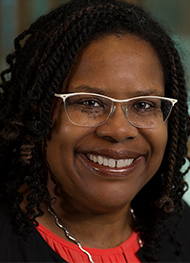
Danielle Conway
Dean and Donald J. Farage Professor of Law
Penn State Dickinson Law
In 2020, the cascade of murders of Black and Brown individuals and the Black Lives Matter protests demonstrated the prevalence of systemic, structural, and institutional racism. Structural racism permeates our democratic institutions, including legal education and the legal profession. For example, LSSSE data from that same year reveal that “[a]lmost a quarter (23%) of Black law students nationwide say their schools do ‘very little’ to create a supportive environment for race/ ethnicity, compared to just 6.8% of White students.”

Similarly, the LSSSE 2020 Annual Report Diversity & Exclusion revealed that students of color need greater institutional support to avoid being stigmatized on campus, as “14% of Native Americans, 18% of Latinx students, and a full quarter (25%) of Black students believe their schools do ‘very little’ to emphasize that students are not stigmatized based on identity.”
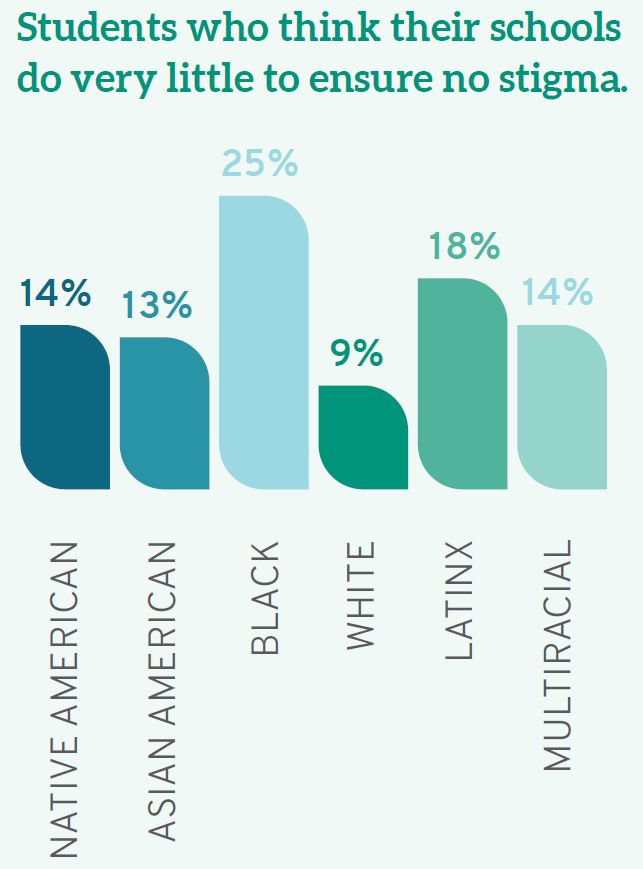
Penn State Dickinson Law has created the Antiracist Development Institute (ADI) to work in coalition with organizations and institutions to help facilitate dismantling structures that scaffold systemic racial inequality using a systems design approach. Systems design, leveraging design thinking approaches, is a vehicle to iteratively identify users and their needs to prototype and test solutions to seemingly intractable problems such as systemic racial inequality and systemic oppression. Legal education and the legal profession are starting points because of their special duty to deliver on equal justice. The ADI has identified institutional antiracism as a significant component of a multilayered strategy in the pursuit of systemic equity.
This interdisciplinary approach to legal education provides law students and lawyers the critical thinking skills that accompany introspection about the role of legal education and the legal profession in creating, interpreting, and counseling of laws that have scaffolded structural racism in American society in contravention of the fundamental value of equality vis-à-vis equal liberty, equal justice, equal citizenship, equal rights, and equal protection of the laws.
The ADI builds on the concepts and information presented throughout the “Building an Antiracist Law School, Legal Academy, and Legal Profession” book series to provide law schools and other institutions with a blueprint that will be workshopped through the stages of systems design.
“Building an Antiracist Law School, Legal Academy, and Legal Profession” is distinct in its use of a systems design approach combined with antiracist principles to transform law schools from edifices of systemic inequity into sustainable democratic institutions whose platform is built upon principles of systemic equity. It is unique for its admixture of systems design, organizational theory and practice, and antiracist theory and practice. The book series is the precursor from which the Antiracist Development Institute will use series content to develop course and workshop materials.
Over 155 colleagues from the legal academy, legal profession, and adjacent organizations are contributing to the book series as chapter contributors, editors, content reviewers, and workshop facilitators, representing 62 institutions across the country.
To get involved in this project, please complete this involvement survey.
Guest Post: From Candidate to Law Student: Collaboration and Collective Efforts to Support LGBTQ+ Inclusion
Guest Post: From Candidate to Law Student: Collaboration and Collective Efforts to Support LGBTQ+ Inclusion

Elizabeth Bodamer, J.D., Ph.D. (she/her/ella)
Director of Research
Law School Admission Council, Inc. (LSAC)

Judi O'Kelley, J.D. (she/her/hers)
Chief Program Officer
National LGBTQ+ Bar Association (LGBTQ+ Bar)
The 2022 matriculant class in law school today is the most diverse class in the history of legal education. We have made progress, but there is more work to be done.
Diversity, equity, and inclusion efforts are needed not just at the admission stage, but throughout the prelaw-to-practice pathway. Law schools play a crucial role in creating an effective and supportive learning environment is important for everyone, particularly for LGBTQ+ students. LSSSE data shared in a blog post last year reveal that gender diverse and LGBQ law students were more likely than cisgender and straight students to report not feeling comfortable being themselves at their law schools.
Figure 1: Students Reporting Not Feeling Comfortable Being Themselves

Source: Data from the 2020 Law School Survey of Student Engagement Diversity and Inclusiveness Module. Data collected from over 5,000 law students across 25 law schools. LGBQ students represented about 14% of the sample and gender diverse students represented 1% of the sample.
It is within this context that LSAC and the LGBTQ+ Bar have worked to provide candidates, students, and law schools with data about the experience of LGBTQ+ students in addition to information about the availability of LGBTQ+ inclusive policies, practices, supports and resources.
Surveys administered by LSAC and by the LGBTQ+ Bar have found that schools are making progress in supporting LGBTQ+ applicants, students, faculty and staff. For example, the LGBTQ+ Bar found that that 99 participating schools (96.1% of survey participants) self-report that they allow transgender and nonbinary students who have not legally changed their names to have their name-in-use reflected on applications and forms. This is a positive change from a number of years ago. The next stage of inquiry is whether schools are implementing these policies and practices in a way that improves the student experience. LSAC found that of the 110 schools who responded to their question about chosen name usage:
- 67% reported that students’ chosen names automatically appear on their orientation name tags and/or materials.
- 49% reported that students’ chosen names automatically appear on faculty class rosters, 41% reported that this action requires students to submit a request, and 5% reported that students’ chosen names cannot appear on faculty class rosters.
- Only a very small proportion of schools indicated that students’ chosen names automatically appear on their transcripts (15%) and diplomas (14%).
- Almost 40% of schools reported that students’ chosen names cannot appear on transcripts that can be sent to employers.
- Almost one-third of the schools reported that students’ chosen names cannot appear on their diploma.
Woven together, the work done by the LGBTQ+ Bar and LSAC reveal that while progress has been made in creating a more inclusive experience for LGBTQ+ students, there are areas for growth.
Supporting the LGBTQ+ community in legal education takes a collective effort. Today, we know that according to LSAC data, about 0.6% of the 2022 matriculant class self-identified as transgender, gender nonbinary, or genderqueer/gender fluid, and about 14% of the 2022 matriculants identified as LGBQ+ (i.e., not straight/heterosexual). We expect these numbers to continue to grow given the latest 2022 Gallup report that about 1 in 5 Gen Z adults identify as LGBTQ+. To support this new class and all future law students, LSAC and the LGBTQ+ Bar are collaborating to administer a joint 2023 LGBTQ+ survey to law schools. The goal is to combine our efforts to build on our robust resources and insights for applicants, current law students, and schools. In order to have impact, we must work together.
Guest Post: The Importance of Supporting First-Generation Law Students
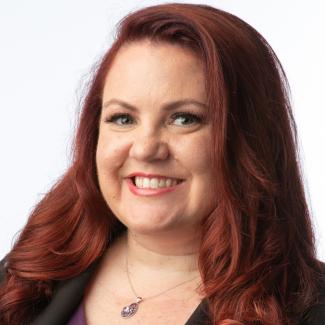 Melissa A. Hale
Melissa A. Hale
Director of Learning for Legal Education
Law School Admission Council
Today is First-Generation Student Day[1]! So, to celebrate, I want to talk about why we should support first-generation law students, and how we can do that.
Who are first-gen students? Although definitions vary and self-identification is important, a first-generation student is typically one whose parents or legal guardians have not completed bachelor’s degrees [2]. First-generation students are an important part of diversity, equity, and inclusion. However these students are often overlooked when discussing DEI goals. In fact, when I started law school[3], I’m not even sure the term “first-generation student” was being used, or if it was in some circles, students certainly weren’t recognizing the term or identifying as “first-gen” the way they are now.
It’s certainly progress that we, as educators and researchers, are recognizing this group of students, but that’s not enough. We need to do more. Especially because there is significant intersectionality between first-generation students and historically underrepresented BIPOC students, including students of color and students from a lower socioeconomic status. According to the Law School Survey of Student Engagement (LSSSE), 29% of law students are first-generation. Students of color are more likely than their white classmates to be first-generation. More than half of all Latinx students, 45% of Native American students, and 40% of Black or African American students are first-generation.
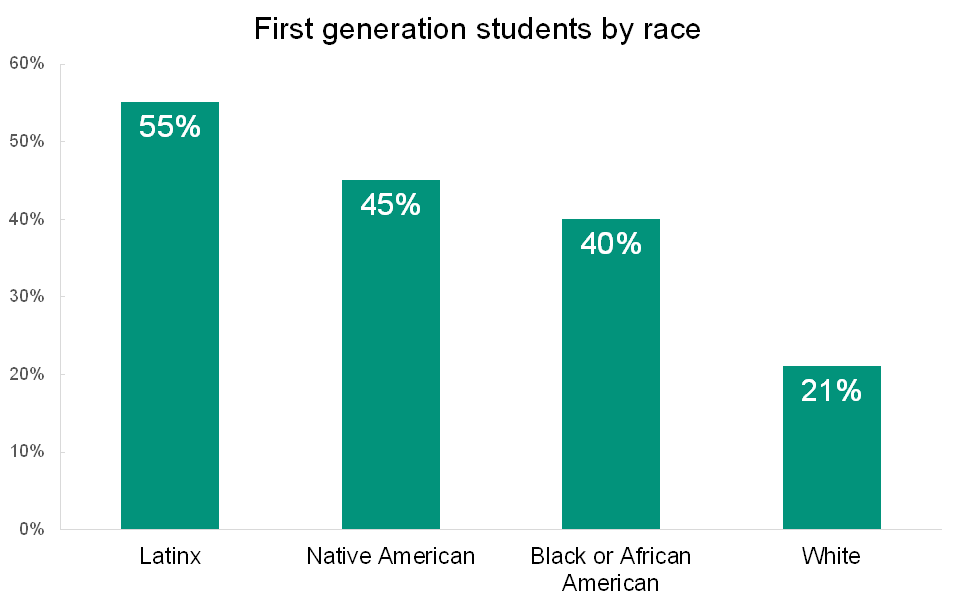
What Makes First-Generation Students Different?
So why does this matter and why is this group different? Well, first-generation law students often come to law school with fewer resources than their peers, including a lack of social capital. Most importantly, they also come to law school bearing an “achievement gap.” The “achievement gap” refers to the disparity in academic performance – grades, standardized-test scores, dropout rates, college-completion rates, even course selection and long-term success– between groups of students. In this instance, we are referring to the gap between students who have had parents complete some form of higher education (“continuing-generation students”) and those that have not. The Close the Gap Foundation refers to this as “the opportunity gap” instead of the achievement gap, and specifically states that it is “the way that uncontrollable life factors like race, language, economic, and family situations can contribute to lower rates of success in educational achievement, career prospects, and other life aspirations.”[4]
This gap becomes obvious when you look at the data. In the 2021 LSSSE survey, 31% of continuing generation students earned a A- or higher. For first-generation students that number was only 24%. While this might not seem like a staggering gap, without networking and family connections, first-generation students have to rely more heavily on grades for job prospects, so that gap can make a significant difference to their future.[5]
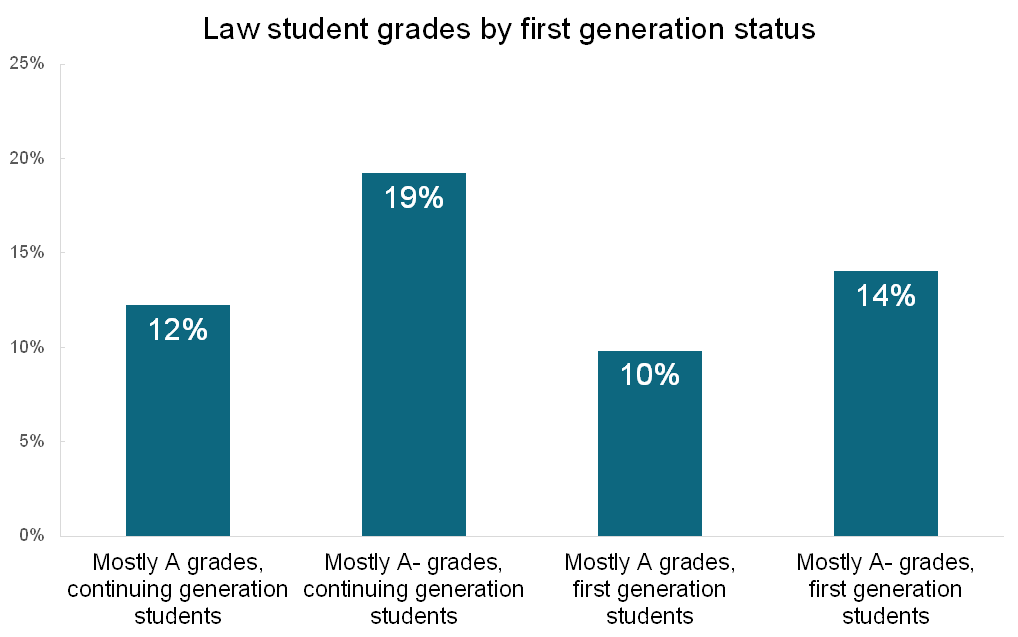
As for social capital, in all professions and cultures there are unwritten rules and norms, generally learned from observing others or knowing people in the culture or profession. Essentially these are not rules you learn about in any explicit way. There is no way for students to study up on these rules, no matter how diligent or well-prepared they are, because they are acquired only through experience. While incoming law students start to pick up on some of these rules during their undergraduate programs, there are still huge gaps where law school and the legal profession are concerned.
Finally, it is far more likely that first-generation students will be providing care for a dependent, either a parent or a child. In fact, 11.3% of first-generation students care for a dependent more than 35 hours per week, as compared to only 5.2% of continuing-generation students.[6] In addition, first-generation students typically end up working more hours, either in legal or non-legal jobs, than their continuing-generation counterparts.
Taken all together, this means that most first-generation students come to law school with considerable hurdles: lower access to finances, lower social capital (i.e., fewer networking connections), lack of exposure to professional norms, and finally, hurdles related to academic preparation, especially when so much of the language used in law school might be brand new to them. And first-generation students themselves know this, coming to law school with concerns surrounding academic success, their career path, building a professional network, finances and family obligations.[7]
What Can We Do?
As legal educators we can do so much. And this starts at the point of admissions. Today, I’m speaking on a panel at LexCon ’22[8] called "Empowering First-Gen Students Through Your Schools' 'Hidden Curriculum,'" along with Morgan Cutright of AccessLex, Teria Thornton, and Susan Landrum, Dean of Students at Illinois College of Law.
Our panel is discussing ways to support first-generation students through the admissions process, navigating financial aid, and finally with academic support once they enter law school. The first step is having these discussions because we often don’t realize the challenges that first-generation students face or what resources they might lack. This is an opportunity for student facing law school professionals – student services, academic support, financial aid, admissions, career services and other administrators – to think through what information we take for granted and then how to make the transition for students a bit easier and more welcoming. For example, even recognizing that many choices they make might be based around financial considerations and scholarships, or staying close to family. Or that purchasing books so that they can read the first class assignment might prove difficult if financial aid checks aren’t distributed before classes begin. Another challenge might be career services assuming that all students have interview appropriate clothes to wear, or can afford such clothes. Some schools have set up interviewing closets where professors and alumni donate old suits for students.
Beyond conversation, at the point of admission, schools can also provide students with a wealth of resources that will help them feel like they belong in law school, and reinforce the message that law school is difficult for all -- not just them. We know that a sense of belonging is linked to positive academic outcomes, such as increased engagement, intent to persist, and achievement[9] However, first-generation students report less belonging, which then increases the achievement gap mentioned above. In addition, students who don’t feel they belong also find it much more difficult to persist in the face of struggle, or even reach out for assistance.
As an example of how we can address a sense of lack of belonging, I used to send incoming students a “law school glossary” upon admissions. It was fairly simple, only a few pages of common words that we tend to use. This was sent to all students, not just first-gen, because some of the terms we use on a daily basis are mystifying to anyone who is new to the study of law. For example, what is a “1L” or what on earth is “K” or “Civ pro”? Abbreviations and acronyms can be just as daunting, and alienating, as the Latin often used.
Because first-generation students often assume that everyone else knows things that they don’t, they might hesitate to ask what are perfectly reasonable questions. Providing them with a quick list of frequently used terms is a great way to decrease feelings of uncertainty. This glossary turned into a book – The First Generation’s Guide to Law School[10] – which was essentially the memo I wish I had received before I started law school. I couldn’t cover everything, but tried to cover most of the unwritten rules surrounding law school, as well as the core academic skills needed to thrive. I wanted to make sure that students could go into their first week of classes feeling confident.
In addition, there are many summer bridge programs that exist. I’m currently working on such a program for the Law School Admission Council (LSAC), and it will be available in the summer of 2023. We had a small bridge program in 2022, Law School Unmasked, and received positive feedback from students on how it increased their feelings of confidence and belonging, and generally increased their ability to succeed in their first semester.[11] For example, “It was very helpful for me as a first generation college and now law student since I do not have anyone I can turn to for help with these topics we went over. Figuring out how things work as a first generation student constantly seems like an uphill battle of asking lots of questions to lots of people who always seem to have vastly different answers and then finding out which answers are correct. This program helped to answer a lot of questions that would have made me feel lost for the first semester of law school.” This shows that programs designed for first-generation students can and do make a difference!
Finally, I encourage all schools to support the formation of a first-generation law student group. This can help ensure first-gen students feel connected, and in a very obvious way, realize they aren’t alone. When I was in law school, I assumed that I might be the only person in the building who didn’t have parents who went to college. However, when I started writing my book – and asking for stories and advice – I discovered that many of my friends and professors were, in fact, also first-generation students. This was shocking to me. So a student group, first and foremost, signals to students that they aren’t the only ones. LSAC is currently working on a National First-Generation Law Student Group, and meeting with already existing student groups to find the best ways to support and foster these types of student organizations.
If you have questions about how to support first-generation students, please feel free to reach out to me at mhale@lsac.org.
[1] Cite 3
[2] FAQ: First-Gen Definition, The Center for First-generation Success, https://firstgen.naspa.org/why-first-gen/students/are-you-a-first-generation-student.
[3] Way back in the dark ages in 2003.
[4] Close the Gap Foundation, last visited May 18th, 2022 https://www.closethegapfoundation.org/glossary/opportunity-gap?gclid=Cj0KCQjwspKUBhCvARIsAB2IYuscRgwXvBQgnHlxQtXJ34Bw4m8g4X_HdMdS_csWATPxgPN0dzuk6eUaAuwKEALw_wcB
[5] id.
[6] Law School Survey on Student Engagement, LSSSE Survey Tool 2021, https://lssse.indiana.edu/about-lssse-surveys/ 1 (Last visited Jan. 17, 2022).
[7] Id.
[8] https://web.cvent.com/event/e2323c1d-5bfb-4ab2-aad0-3cc606276ab1/summary
[9] Id.
[10] https://cali.org/books/first-generations-guide-law-school
[11] https://www.lsac.org/law-school-unmasked
A Critical Tool for Dean and Faculty Leaders

A Critical Tool for Dean and Faculty Leaders
Austen L. Parrish
Dean and Chancellor’s Professor of Law
University of California, Irvine School of Law
The job of a law school dean has changed. If once to be “successful... you need[ed] to be a distinguished scholar,” now the day-to-day responsibilities of a law dean are much more varied and complex. Just recently, a piece in Bloomberg Law explained that if the “[l]aw school dean once was a dream job . . . [t]hese days, the position is more like being chief executive of a sprawling business than a tweed-clad dispenser of constitutional wisdom.” A landmark Association of American Law School’s study on the American Law School Dean underscored that during the pandemic deans spent considerable time on crisis management, on issues related to diversity, equity, inclusion, and on topics of student life and student conduct. The pressures of continued intense hyper competition—whether that’s recruiting and retaining talented students, faculty, and staff; the complexity and demands of core operations, including admissions, career services, communications, finance, student services, among others; and the need to enhance the school’s research, teaching, and service missions, while navigating complex university labyrinths—in many ways reflects that higher education itself operates in a much more complex context than it once did.
As the role of the dean has become broader and more complex, the need for quality data upon which to track progress and base decisions has become more important. In the last decade, the resources available to law deans have expanded dramatically. AccessLex Institute’s Analytix, which aggregates ABA data about legal education, its research and data portal, and its annual legal education data deck are some of the best and most useful examples. The AALS compendium of data resources, the Law School Admission Council’s data on admissions and student recruitment, and the National Association of Law Placement’s research and statistics are others. In my own experience, when it comes to gauging student engagement and the student experience, few resources are more useful than the Law School Survey of Student Engagement (LSSSE).
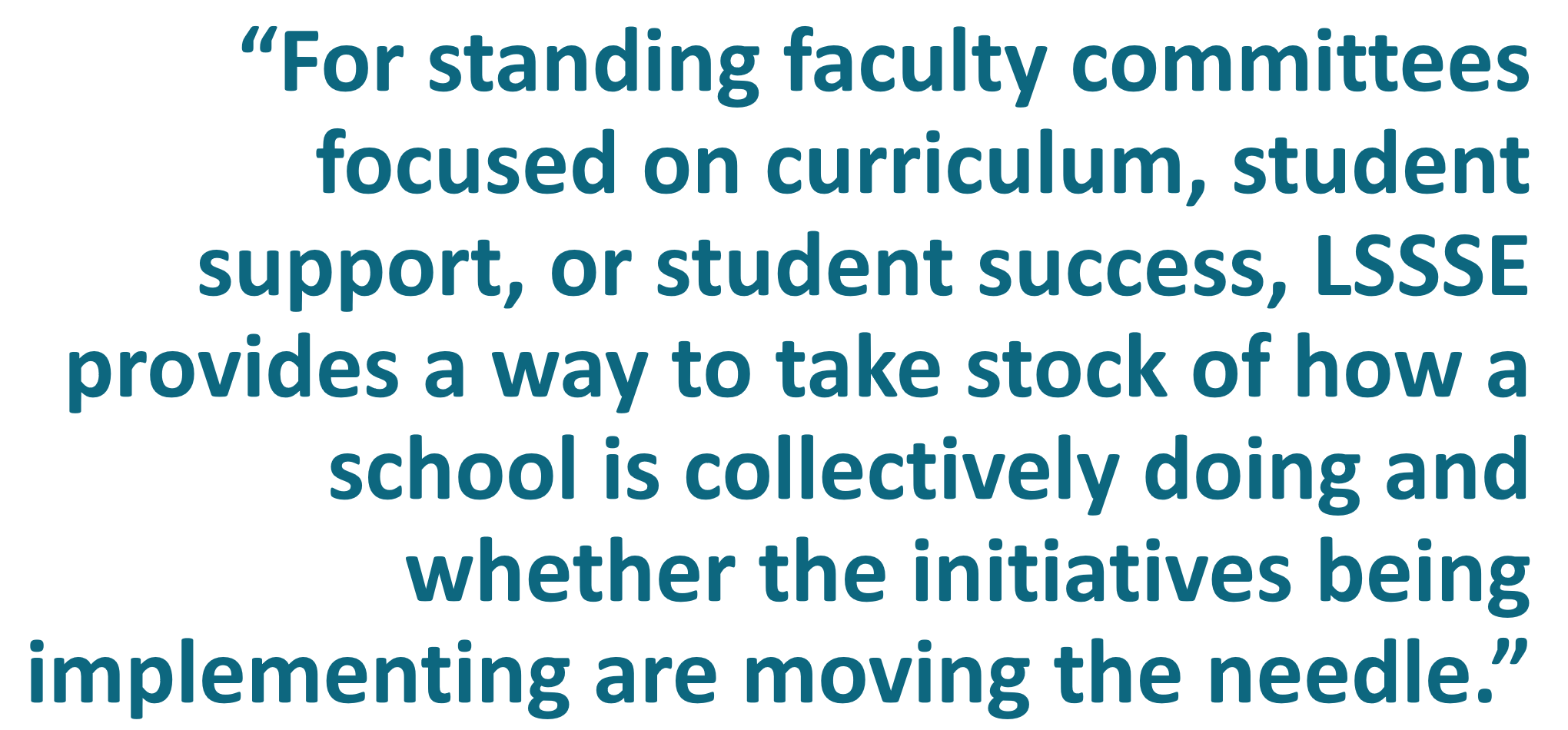 LSSSE helps with data-driven decision-making. Schools that have consistently taken advantage of LSSSE now have a wealth of longitudinal information from over 17 years of surveys. I’ve found, however, that the survey also has a more straightforward function. If we care about our students and their experiences, why wouldn’t we want to track and measure student perceptions of that experience? And tracking those perceptions over time provides some indication of whether we’re making progress on our goals. Comparisons with other institutions are useful in creating benchmarks too. For standing faculty committees focused on curriculum, student support, or student success, LSSSE provides a way to take stock of how a school is collectively doing and whether the initiatives being implementing are moving the needle.
LSSSE helps with data-driven decision-making. Schools that have consistently taken advantage of LSSSE now have a wealth of longitudinal information from over 17 years of surveys. I’ve found, however, that the survey also has a more straightforward function. If we care about our students and their experiences, why wouldn’t we want to track and measure student perceptions of that experience? And tracking those perceptions over time provides some indication of whether we’re making progress on our goals. Comparisons with other institutions are useful in creating benchmarks too. For standing faculty committees focused on curriculum, student support, or student success, LSSSE provides a way to take stock of how a school is collectively doing and whether the initiatives being implementing are moving the needle.
Personally, I have found it’s the bread-and-butter questions of the survey that are most helpful. How satisfied are our students in the career counseling, personal counseling, academic advising, financial aid counseling, as well as library and technology assistance they receive? How often and in what ways do our students interact with faculty? The responses don’t tell you as a dean or a faculty committee what to do, and the questions measure perceptions as much as anything, but the survey responses provide important insight into the extent our students are feeling supported, and whether we’re building the inclusive, rigorous academic community we want. And on a year-to-year basis, the survey provides red flags and early warning signals if there’s a sudden drop in an area. It also provides reasons for celebration and congratulations to staff over sustained improvement. Of course, if you care about fundraising, questions asking students to evaluate their overall law school experience, and whether if they could start over they would attend the same law school, are critical. And for being a dean in California, where the bar exam is notoriously exclusionary, the new AccessLex and LSSSE partnership that seeks to explore the connections between student engagement and bar performance is a welcome development.
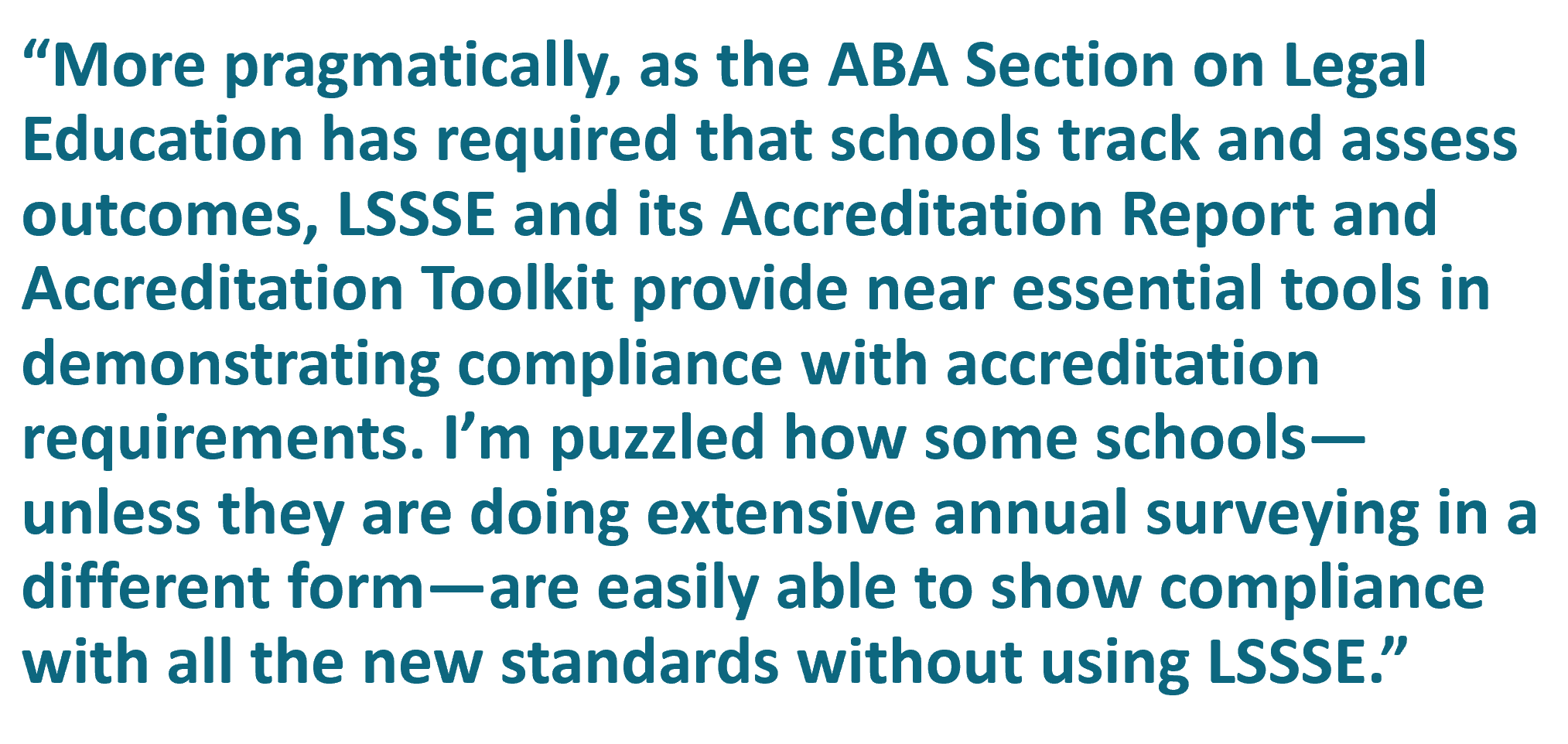 I’ve found LSSSE useful in other ways too. For one, LSSSE’s special reports have been insightful on providing a perspective on issues that I care about, and that I know many of my dean colleagues care about too. The 2020 Annual Report, Diversity & Exclusion, or the special report on The Changing Landscape of Legal Education, which provides a 15-year retrospective, both come to mind. More pragmatically, as the ABA Section on Legal Education has required that schools track and assess outcomes, LSSSE and its Accreditation Report and Accreditation Toolkit provide near essential tools in demonstrating compliance with accreditation requirements. I’m puzzled how some schools—unless they are doing extensive annual surveying in a different form—are easily able to show compliance with all the new standards without using LSSSE.
I’ve found LSSSE useful in other ways too. For one, LSSSE’s special reports have been insightful on providing a perspective on issues that I care about, and that I know many of my dean colleagues care about too. The 2020 Annual Report, Diversity & Exclusion, or the special report on The Changing Landscape of Legal Education, which provides a 15-year retrospective, both come to mind. More pragmatically, as the ABA Section on Legal Education has required that schools track and assess outcomes, LSSSE and its Accreditation Report and Accreditation Toolkit provide near essential tools in demonstrating compliance with accreditation requirements. I’m puzzled how some schools—unless they are doing extensive annual surveying in a different form—are easily able to show compliance with all the new standards without using LSSSE.
LSSSE has been useful for another reason. LSSSE now houses the largest repository of law student data in the U.S. with over 400,000 responses over seventeen years. That’s a powerful tool for researchers, but it’s also just helpful for deans to do their jobs. It’s not enough for a law dean to know what’s happening in their own school. Alumni, provosts, presidents, and other stakeholders want to know trends in legal education. Having a broader, empirical view of the changes of legal education is useful to rebut persistent misinformation and caricatures about legal education.
LSSSE has shown how legal education has changed in the last seventeen years. The surveys show that there’s room for innovation and improvement and that rising student debt remains a concern. Yet on balance the surveys tell a positive story of school success. Overall levels of satisfaction remain high, and schools have made progress in improving the quality of legal education and the commitment to student support. While variation between law schools can be significant, the surveys reveal an American legal education system that is increasingly diverse, has strong student services with engaged full-time teachers and scholars, and underscores that schools overall have strengthened their commitment to supporting students in their path to launching satisfying careers (with academic, career, and personal advising).
LSSSE is a valuable tool for deans. One that I’ve used consistently over the last decade, and one I will continue to use.
Guest Post: What’s Actually At Stake in the SCOTUS Challenge to Race-Conscious Admissions
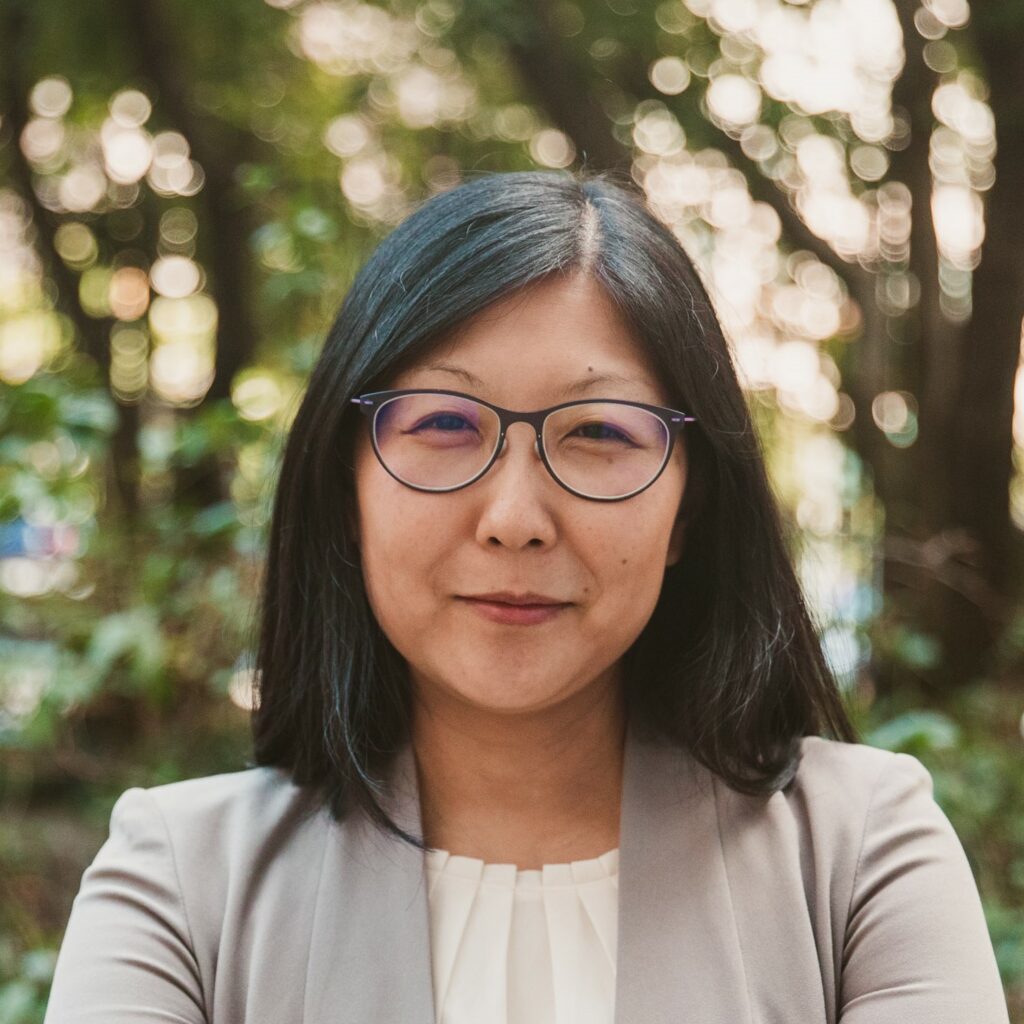
Shirley Lin, Assistant Professor of Law
Brooklyn Law School
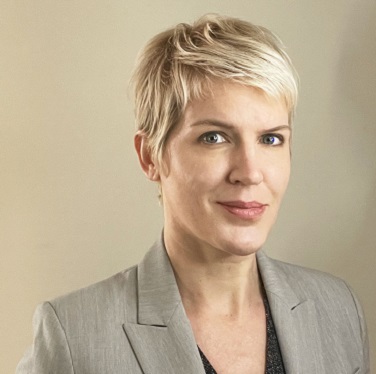
Clara Williams ‘23
Brooklyn Law School
Consider the following hypothetical law school candidate. She is a child of limited-English-proficient immigrants, growing up in a majority-minority neighborhood of Queens, New York. Her community and adjoining zipcodes had been deprived of public investment for decades. She and her siblings were the first in their household to graduate high school, then college. Because of their race and ethnicity, they experienced harassment from a young age and, one of them, a violent beating in high school. By the time she applied to law school, she took her first course in standardized testing just before her second and final attempt on the LSAT. Co-author Professor Lin’s experience with affirmative action in higher education would have been markedly different if the Supreme Court decides to overturn four decades of precedent allowing schools’ admissions programs to consider race along with other factors.
After decades of being held up as a racial foil against other communities of color in racial politics—especially in debates over affirmative action—Asian American communities are wary of being used as pawns to undo efforts to address racial inequality. After withstanding repeated challenges to affirmative action, in 2003, the Court reaffirmed the current doctrine that admissions programs may consider race among other factors that contribute to campus diversity in Grutter v. Bollinger. In tandem appeals against Harvard and University of North Carolina, petitioner Students for Fair Admissions (or SFFA, led by a white affirmative action opponent, Edward Blum), now seeks to do so again in a bid to undo the practice of race-conscious admissions entirely.
Statistics are central to SFFA’s challenge on several levels: in evaluating how interested parties have positioned racial categories; in illustrating what is at stake; and in contextualizing the relevance of these appeals to legal education. In fact, for nearly a decade, the majority of Asian American voters have supported affirmative action—today, at nearly 70 percent. This includes the 6,000-member Harvard Asian American Alumni Alliance (H4A, representing all of Harvard’s Schools), which joined amici student and alumni groups supporting Harvard’s ability to consider race in its admissions process. H4A has underscored that a racially diverse student body creates the best educational environment for everyone—including Asian Americans.
Emphasizing a consistent line of studies demonstrating that racial diversity increases tolerance and empathy across racial lines, the Asian American Legal Defense & Education Fund filed an amicus brief last month in support of the respondent universities, on behalf of 121 AAPI scholars and community group signatories (including Professor Lin). Amici highlighted the meteoritic rise in anti-Asian American hate crimes, in particular extremely violent attacks and murders, that persist, in emphasizing the continuing relevance of the benefits of racial diversity that Grutter recognized two decades ago.
Numbering at least 24 million, Asian American communities are kaleidoscopically diverse even in terms of ethnicity and class stratification alone. Asian Americans have undergone profound changes in the last two decades. Their cultural and political experiences nationwide defy pat generalizations about race, phenotype, immigration status, religion, and experiences with language barriers. For example, 12 of 19 subgroups by Asian origin analyzed by the Pew Center currently experience poverty at rates as high as—or above—the level for overall U.S. population. Today, roughly 6 in 10 U.S.-born Asian Americans are members of GenZ (i.e., aged 22 or younger), and another 25% of the population considered Millennials. Their experiences in schools (including legal education) defy the racial stereotypes of Asian Americans that formed a generation or two ago as the “model minority” who can simply, meritocratically, join the middle- or upper-middle-class.
Recent reports from the Law School Survey of Student Engagement (LSSSE) provide a far more accurate picture than the briefs provide. For example, during the ongoing COVID crisis, concerns about access to adequate food and housing among Asian American law students were on par with Black and LatinX law students:
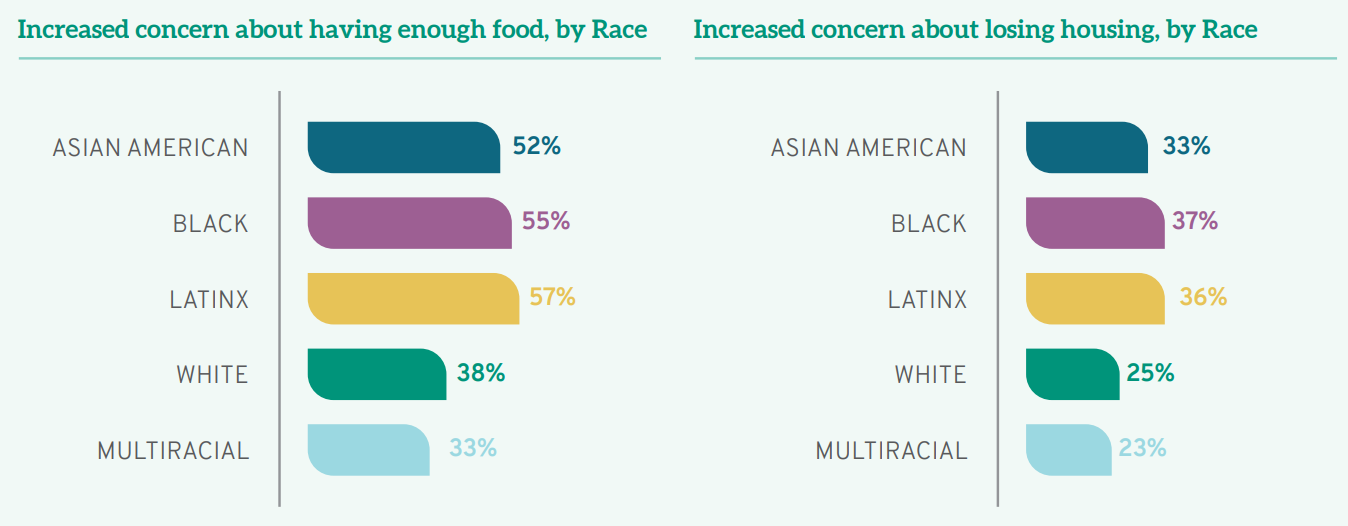
LSSSE, The COVID Crisis in Legal Education (2021)
Meanwhile, LSSSE’s 2020 report providing a 15-Year Retrospective reflects that, in the intervening time since Grutter and its subsequent increase in student racial diversity, students were twice as likely to report that their law school contributed to their understanding people of other racial or ethnic backgrounds— progressing from a paltry 23% to 45%:
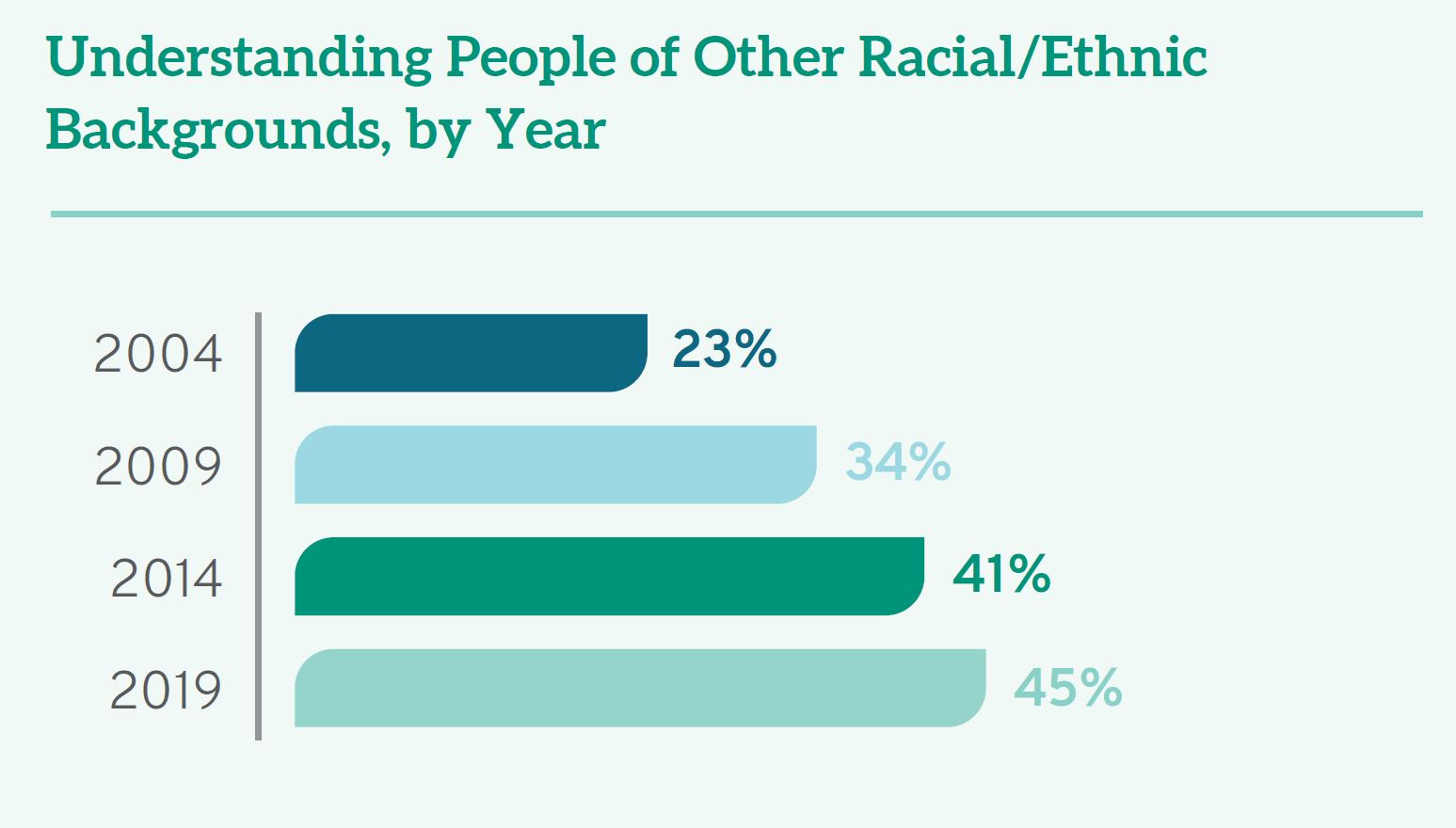
These students’ experiences, of course, predate the ABA’s modest revision earlier this year of law school Accreditation Standard 303(c), which now states: “[a] law school shall provide education to law students on bias, cross-cultural competency, and racism: (1) at the start of the program of legal education, and (2) at least once again before graduation.”
Taking time to drill down into the experiences of subgroups within Asian American communities yields a wealth of information about the similarities and, perhaps just as crucially, the divergent experiences of such a vast grouping. For instance, Vietnamese American students are half as likely as Indian American students to have parents who received a college education. Chinese students comprise 50% of the international students, who are generally not eligible for merit-based scholarships.
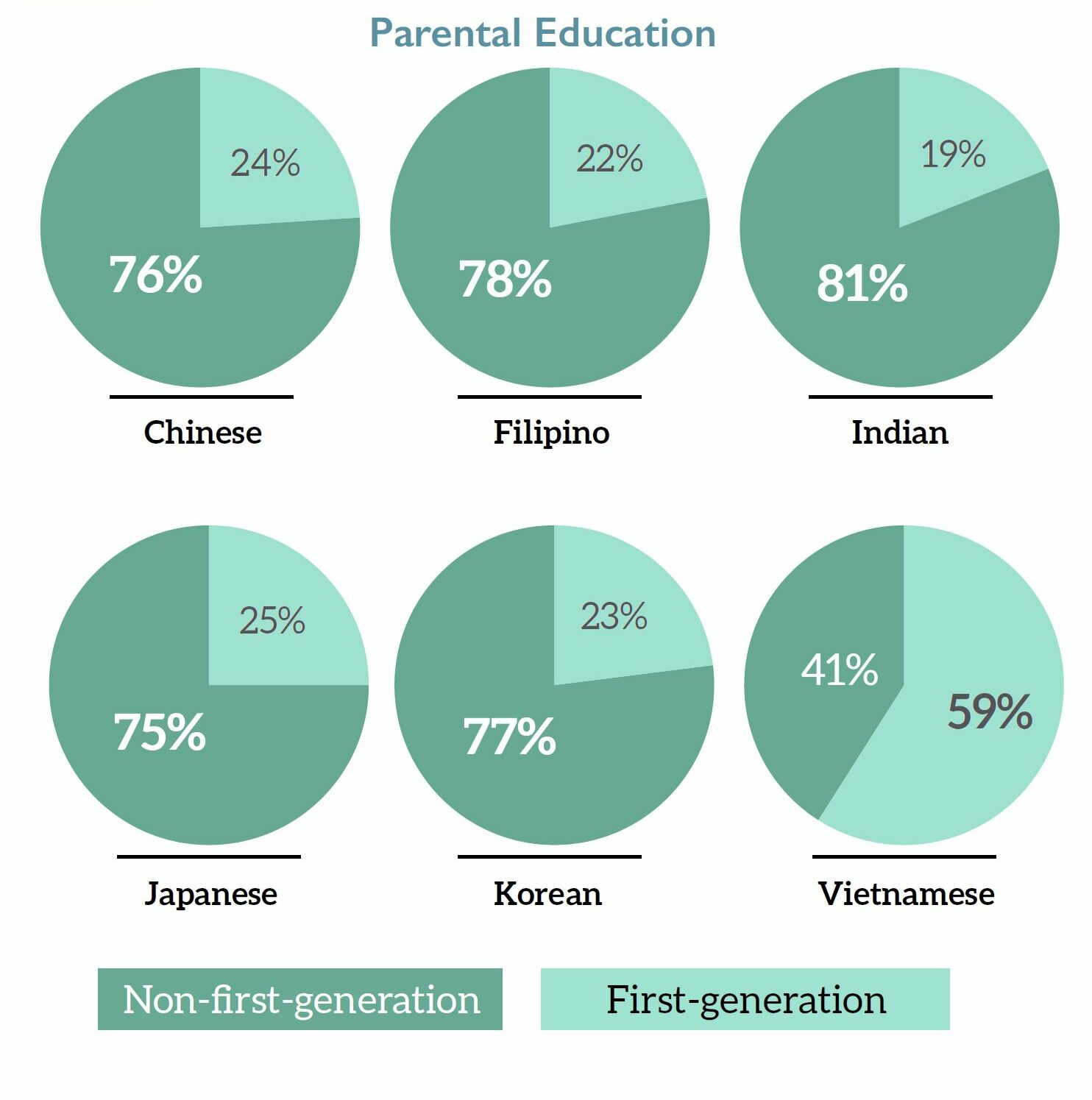
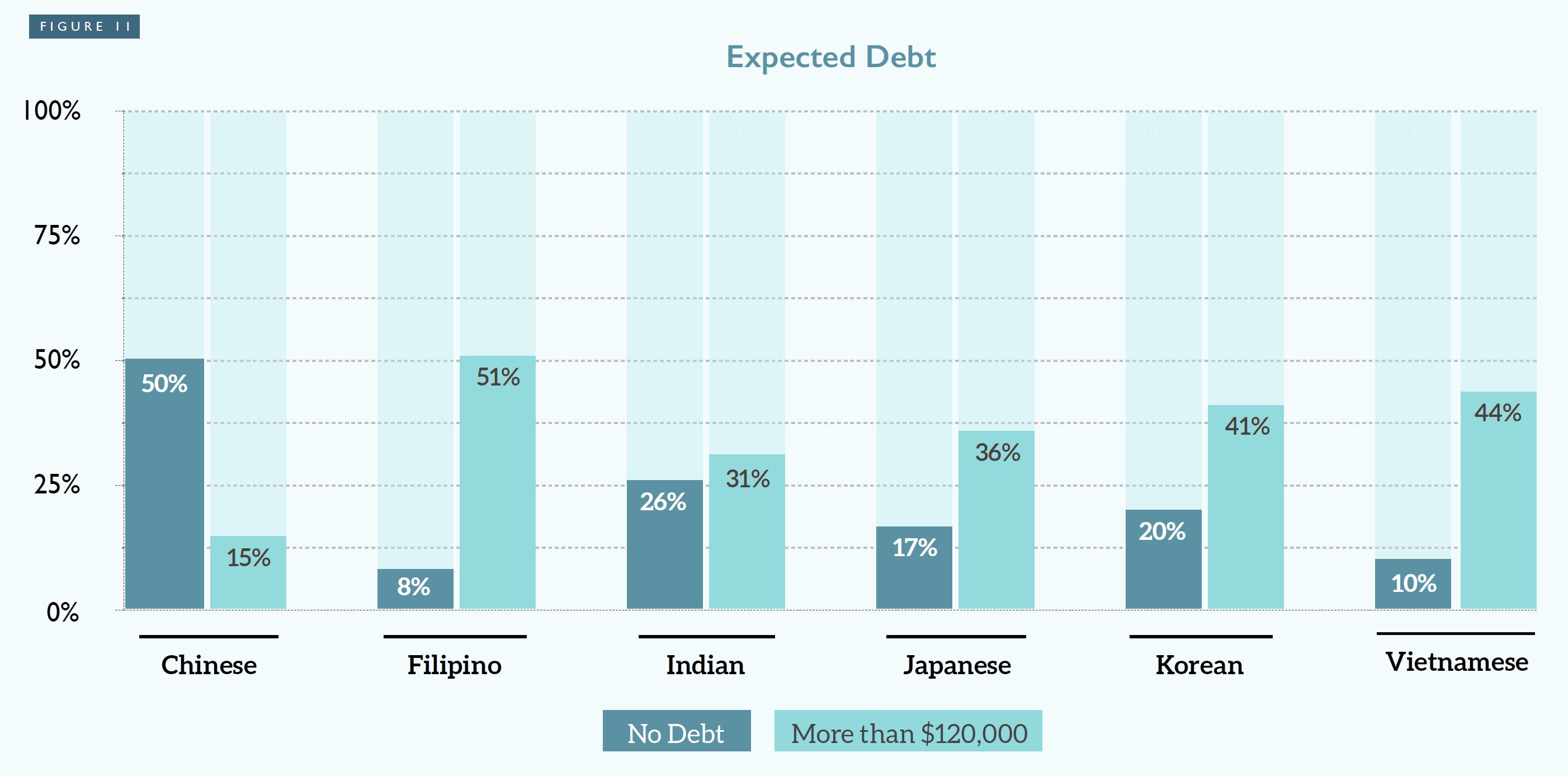
Diversity Within Diversity (2017)
Most troubling is that, in its Harvard litigation, SFFA claims to be concerned with assisting AAPI applicants against “negative action” by proposing as an alternative affirmative action based solely on income. Yet the group avoids acknowledging that such plans ultimately provide the greatest boost to white applicants—not racial minority applicants—because they do not account for additional systemic hurdles racial minorities from impoverished families face. Meanwhile, a ruling that would prohibit the use of race while leaving in place “colorblind” practices that unfairly benefit wealthy white applicants belies SFFA’s professed concern for Asian American applicants.
Rather than confounding admission programs, our current doctrine on race-conscious affirmative action does not prohibit law schools or colleges from assessing the multiple dimensions of advantage and disadvantage as they intersect with race (including for white applicants). To the contrary, it expects schools to assess individual applicants holistically. Students of color—including Asian American students—overcome barriers to the profession compounded by race alongside class, disability, gender, and other dimensions of inequality. Professor Lin’s first-hand experience with the inequities her family and neighbors faced remained central to her pursuit of legal advocacy, and now research and teaching, which investigate how law binds racial and economic injustice. Her unlikely route to academia would scarcely have been possible without the nuanced, race-conscious approaches intact in current doctrine.
Nonetheless, conservative proponents of “colorblindness” will soon ask the Justices to discard nearly 50 years of settled law on race-conscious admissions programs in higher education. At a time when debates over K-12 curricula foreground ideological attempts to silence all conversation about the ways in which race fosters systemic and institutional inequality, SFFA’s blunderbuss legal challenge has—at a minimum—reinvigorated examination of actual racial diversity so that legal academia, too, must take note.
Guest Post: Using Meaningful Admissions Data to Improve Legal Education and the Profession
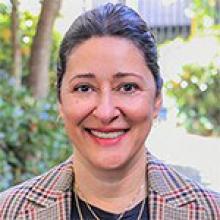
Anahid Gharakhanian
Vice Dean & Director of the Externship Program
Professor of Legal Analysis, Writing, and Skills
Southwestern Law School
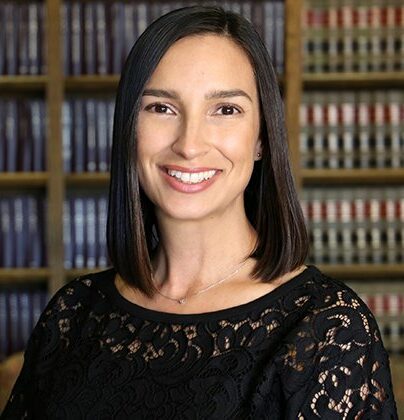
Natalie Rodriguez
Associate Dean for Academic Innovation and Administration
Associate Professor of Law for Academic Success and Bar Preparation
Southwestern Law School
Conversation about increasing diversity and doing better when it comes to inclusion and belonging is everywhere in legal education. What’s critical though is empirically tracking how well we’re actually doing. The Law School Survey of Student Engagement (LSSSE) provides invaluable and sobering data that should serve as a beacon to legal educators’ aspirational goals of cultivating diversity, inclusion, and belonging in their schools and in the profession. LSSSE’s 15-Year Retrospective – The Changing Landscape of Legal Education – tells us that there’s a positive trajectory with minority enrollments from 2004 to 2019.
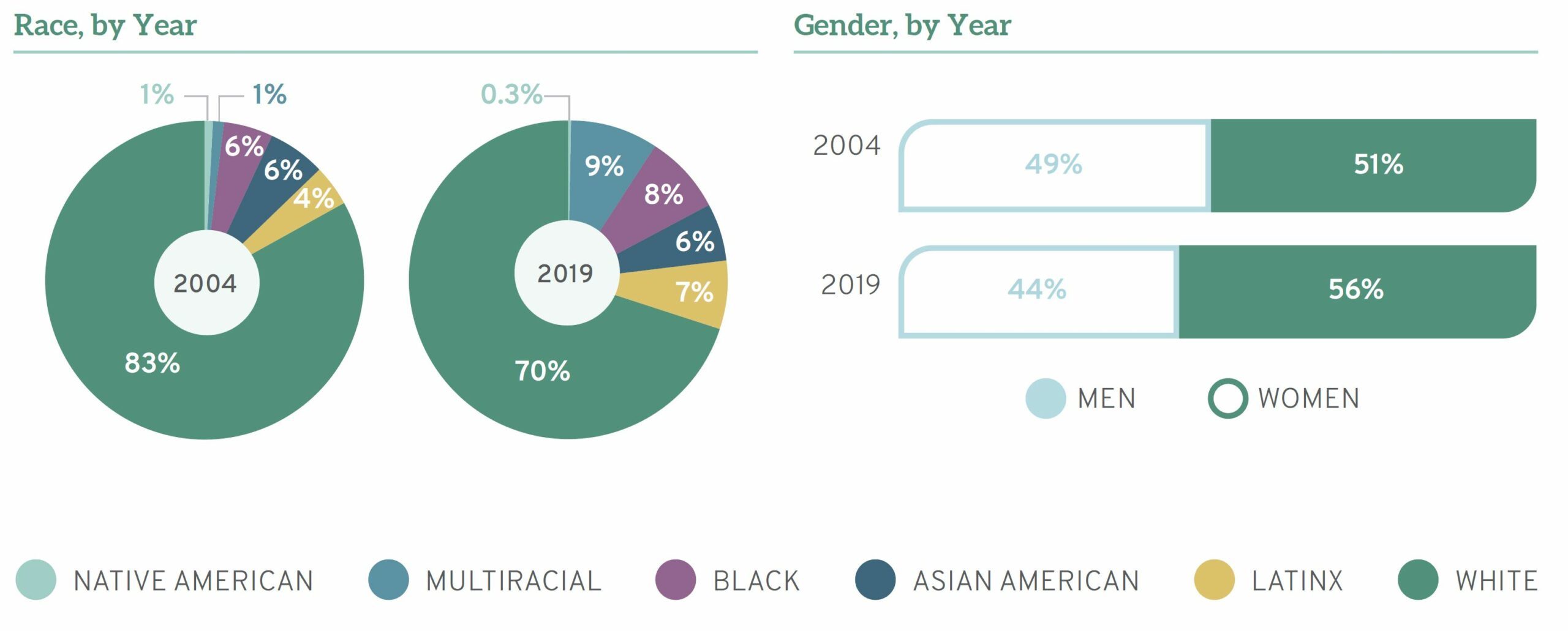
But the jarring news is that minority students’ sense of belonging – especially women of color students– is quite a bit lower than that of White students. As LSSSE’s 2020 Diversity and Exclusion Report points out, “Scholarly research indicates that students who have a strong sense of belonging at their schools are more likely to succeed.”
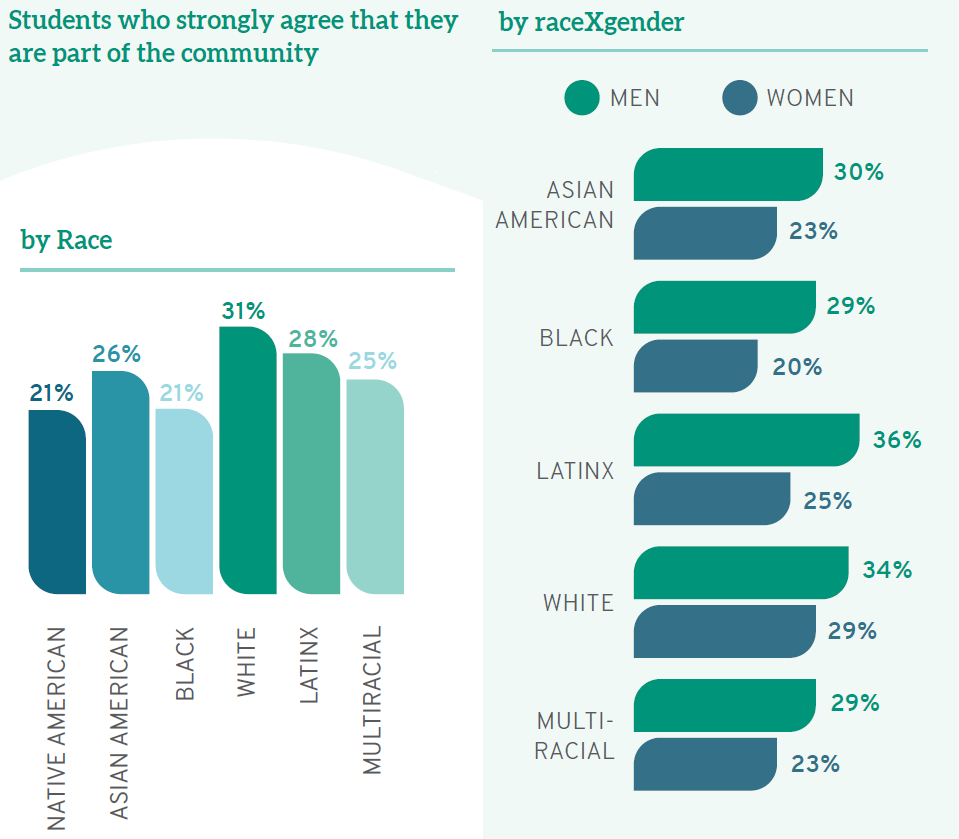
The data unequivocally tells us that we need to do a lot better for ALL law students to succeed. But the effort should start much earlier than when law students start law school. We need rigorous rethinking and innovation in law school admission practices – whereas to date the hyper-focus is on the limited numerical indicators of undergraduate GPA and especially LSAT score.
For the past three years, Southwestern Law School has innovated with such a first-of-its kind approach to admissions practices. The research project and initial results are detailed in “More than the Numbers”: Empirical Evidence of an Innovative Approach to Admission, Minnesota Law Review (Vol. 107, forthcoming), co-authored by the co-authors of this blog and Dr. Elizabeth Anderson, and will be presented at the Minnesota Law Review Symposium, on October 7, 2022, “Leaving Langdell Behind: Reimagining Legal Education for a New Era.” Interestingly, Southwestern’s empirically-based novel approach seems to have provided a notable boost to the matriculants’ sense of confidence or belonging in attending law school. More on that in a bit.
Southwestern’s project is driven by the moral imperative that law schools – as gatekeepers to the legal profession – should commit to innovative and rigorous admissions processes that define merit broadly and provide opportunities based on a spectrum of factors, beyond the traditional numerical indicators. In furtherance of this commitment, several years ago, Southwestern developed an evidence-based tool to more fully and meaningfully assess applicants’ law school potential. This tool goes beyond the limited cognitive measure of the LSAT, which many criticize as an impediment to diversifying law schools and the profession and which at best is only modestly predictive of first year law school performance.
Southwestern’s approach focuses on that group of applicants whose application materials show promise but also raise questions about the applicant’s current readiness for law school. These applicants are invited to participate in a methodical waitlist interview process where they are asked a series of questions based on several factors identified in the IAALS’s Foundation for Practice (“Foundations”) study as necessary for first-year attorneys. Three years into this project and based on hundreds of admission interviews working with Dr. Elizabeth Anderson we have analyzed our approach. The data has produced initial reliability and validity metrics for the measure developed – i.e., a tool that could be used with confidence in the admissions process.
Southwestern’s approach has included three steps. First, Southwestern identified what needs to be measured – i.e., certain foundations necessary for first-year practice as established by the Foundations study and hence assumed to be necessary to law school success. Second, the school identified why these factors need to be measured – i.e., to provide access to legal education with measures that matter. Third, the school designed the empirical research to support the development of a reliable and valid measure of this construct. Relatedly, Southwestern developed a measure of “nontraditional readiness for law school” using a design that focused on a psychometric research design, where psychometrics is the research practice of formal development of reliable and valid measures/assessments. Southwestern has found that the developed tool/measure is measuring what it set out to measure. This tool/measure will produce a score that will then be used in predictive validity analyses, as well as predictive modeling of law school success outcomes.
Interestingly, and beyond the quantitative data, based on comments shared by the interview matriculants, for purposes of adding context to the paper we’ve written about the admissions project, we’ve learned that the interview experience provided a notable boost to their confidence in attending law school. This was not an outcome that Southwestern had hypothesized or planned for but was a palpable part of the comments shared by the matriculants. Seeing the LSSSE data about belonging, it’s imperative that we create a sense of belonging starting with the admissions process.
The matriculant’s comments are indelible. A third-year interview matriculant noted:
I was very nervous when I came to the school for the waitlist interview. But afterward I felt heard and this motivated me. It gave me confidence, and I felt I couldn’t let the school down and I now had the opportunity to follow my purpose.
A second-year interview matriculant noted:
With the waitlist interview, Southwestern made the admissions process more personal and it showed me that the administration really values the lived experience of potential students and wants to hear what I have to say. This gave me confidence about law school and what I can contribute/accomplish.
And a first-year interview matriculant noted:
My waitlist interviewer dug deep and tried to understand me. She heard me, which was incredible. I knew law schools aren’t comfortable taking a chance but I was hoping some schools would want to hear my story and that’s what the waitlist interview did for me. This gave me the chance and confidence to pursue the dream that started with watching Fresh Prince of Bel-Air when I was a kid and thinking it’s so incredible to see Black attorneys and I want to be an attorney.
Our work has been well-received. We recognize, however, there is work left to be done and LSSSE is uniquely positioned to contribute in this area and help drive the necessary change through additional data. As part of its annual survey, LSSSE could include questions designed to gather data on law students’ admissions experiences. As our approach to admissions shows, establishing a sense of belonging can begin well before orientation. This unintended yet profound outcome is worth additional exploration. As indicated in the 2020 Diversity and Exclusion Report, a strong sense of belonging can make the difference in whether a student feels they have the support they need to thrive, especially women of color.
Further, as part of its longitudinal studies, LSSSE could also consider ways to track admissions factors beyond the limited indicators of LSAT and UGPA. The 2020 15-Year Retrospective – The Changing Landscape of Legal Education points out overall drops in UPGAs and LSAT scores.
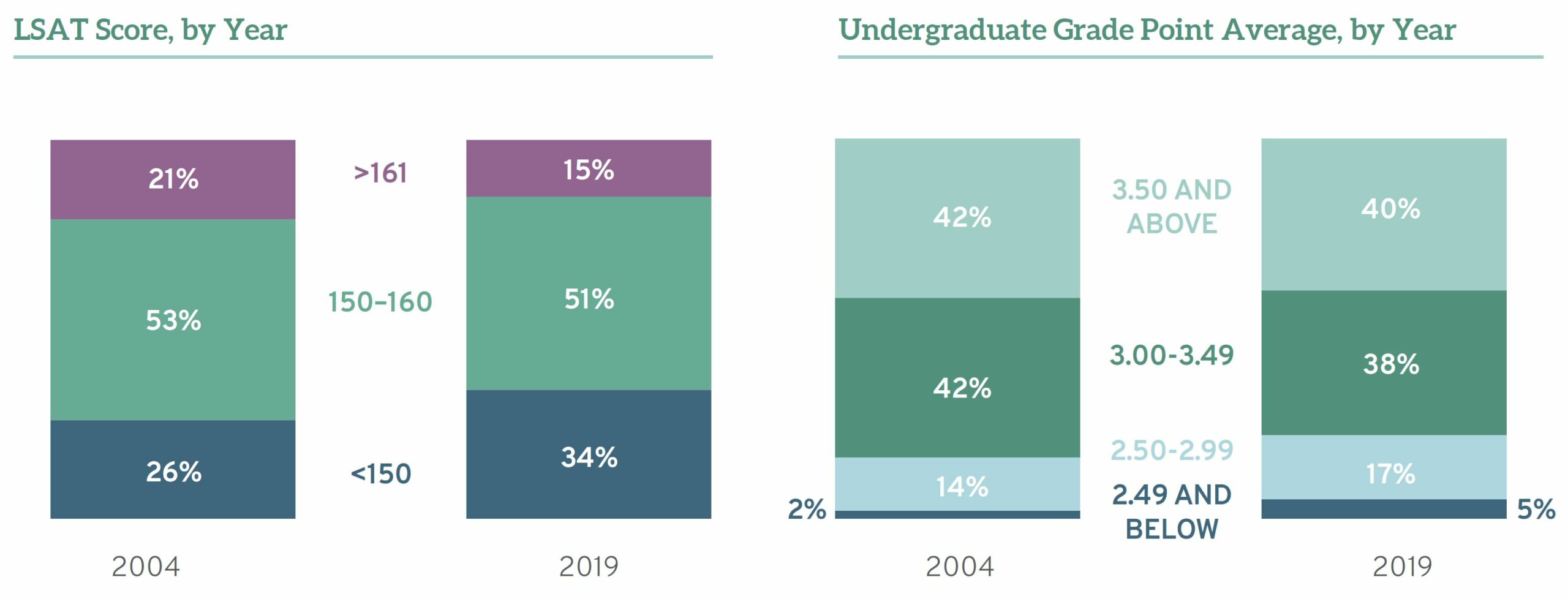
This is helpful information, but the continued hyper-focus on these traditional factors, and not probing into and tracking other admissions-related data, contributes to perpetuation of limiting entry into law school and the profession based on narrow concepts of merit and potential.
These are just a few ideas. But to be sure, empirical inquiry and evidence must lead the way to change in admission practices. With its dedication in working for the betterment of legal education and its rigor in research practices, LSSSE certainly has a critical role to play in encouraging innovative law school admissions practices that more fully and meaningfully assess merit and potential while creating an inclusive and engaging pre-matriculation experience.
Dispelling the Asian American Monolith Myth in U.S. Law Schools
Dispelling the Asian American Monolith Myth in U.S. Law Schools
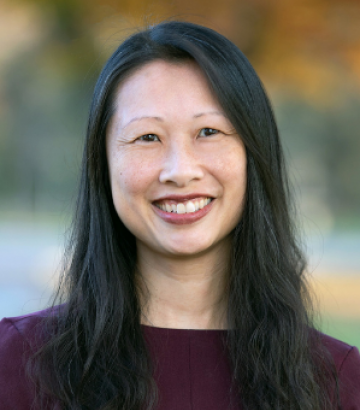
Katrina Lee
Clinical Professor of Law, and Director of Program on Dispute Resolution
The Ohio State University, Moritz College of Law
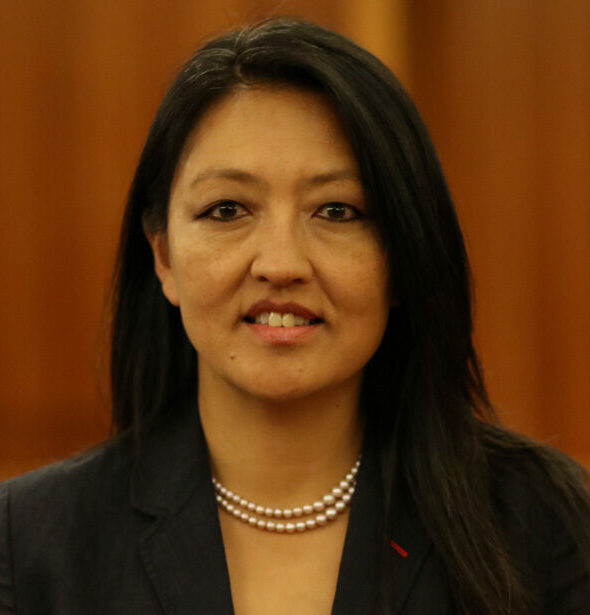
Rosa Kim
Professor of Legal Writing
Suffolk University Law School
In the past year, following an exponential rise in anti-Asian violence and discrimination in the U.S., we wrote an essay about inclusion of Asian American faculty in legal academia. We discussed harmful stereotypes and myths about Asian Americans. We called on the legal academy to do more to acknowledge and address the challenges faced by Asian American faculty and to amplify their voices, work, and presence.
Law schools must also do the same for Asian American students in U.S. law schools.
Asian Americans have often been viewed and treated as a single homogenous group. And yet the story of Asians in America is one of rich diversity. Today more than 20 million people who identify as Asian American live in the U.S.[1] The term Asian American encompasses at least 21 distinct groups.[2] In 2019, people who identify as Chinese, Indian, Filipino, Vietnamese, Korean, and Japanese accounted for 85% of Asian Americans.[3]
Asian Americans are diverse economically. The disparities in income across Asian American households are among the widest in the country. While Asian American households in the U.S. had a median annual income of $85,800 in 2019—higher than the $61,800 among all U.S. households—most groups of Asian Americans report household incomes well below the national median for Asian Americans.[4] For instance, Burmese American households have a median income of $44,400.[5]
Unsurprisingly, Asian American law students[6] are diverse. LSSSE survey data about Asian American students dispels the monolith myth and reveals the need for law schools to act to provide support for all Asian American students. LSSSE’s recent report of Asian American law students is aptly named Diversity within Diversity: The Varied Experiences of Asian and Asian American Law Students.
Within the group of Asian American law students surveyed, 81% of respondents comprised six ethnic groups: Chinese, Korean, Indian, Filipino, Japanese, and Vietnamese.
International students of Asian descent are a growing cohort in U.S. law schools. By far, Chinese respondents were more likely than any other group to be international students; 50% percent of them identified as international students, while just 1% of Filipino respondents identified as international students.
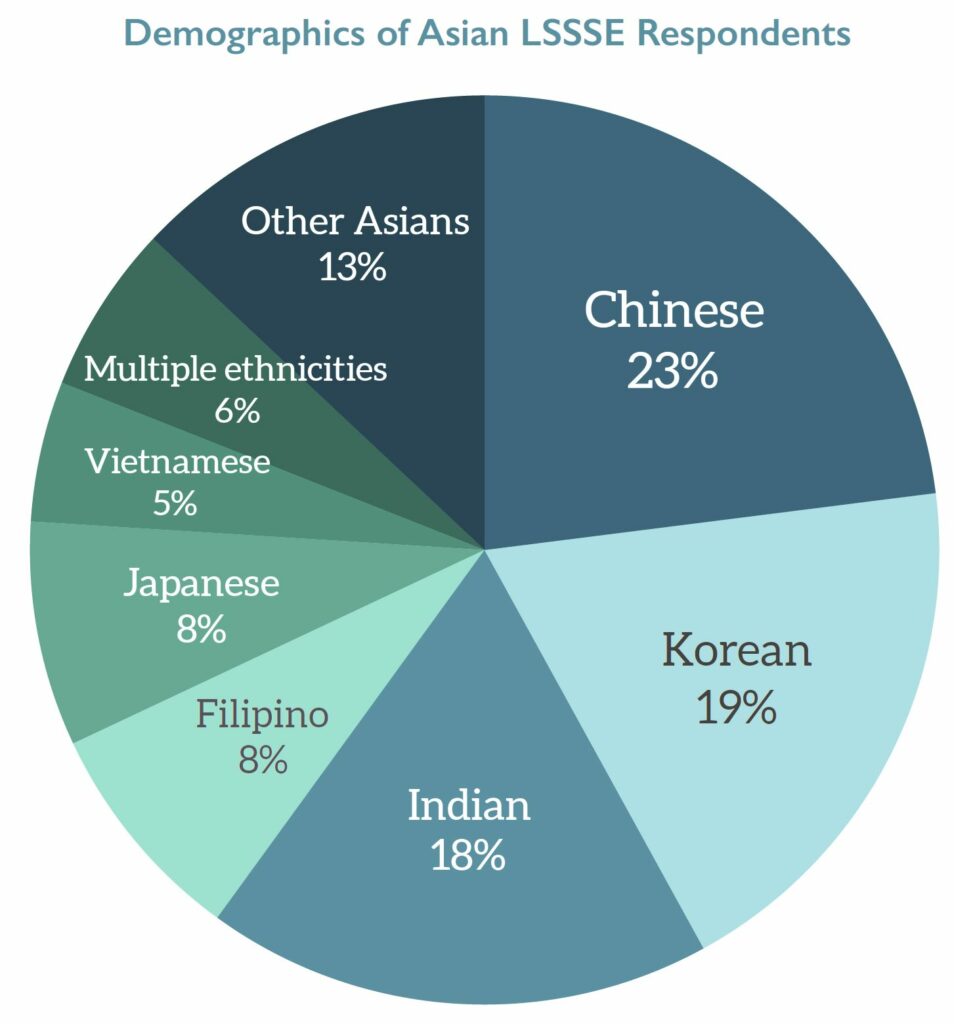

In the areas of LSAT scores and parental education levels, the LSSSE uncovered dramatic differences across ethnic subgroups. About 1 in 3 Chinese respondents had LSAT scores above 160. As a point of comparison highlighting the Asian American diversity, fewer than 1 in 11 Vietnamese respondents had scores at that level. Only 41% of Vietnamese law student respondents had at least one parent with a BA/BS or higher, in contrast with 81% of Indian law student respondents and 78% of Filipino law student respondents.
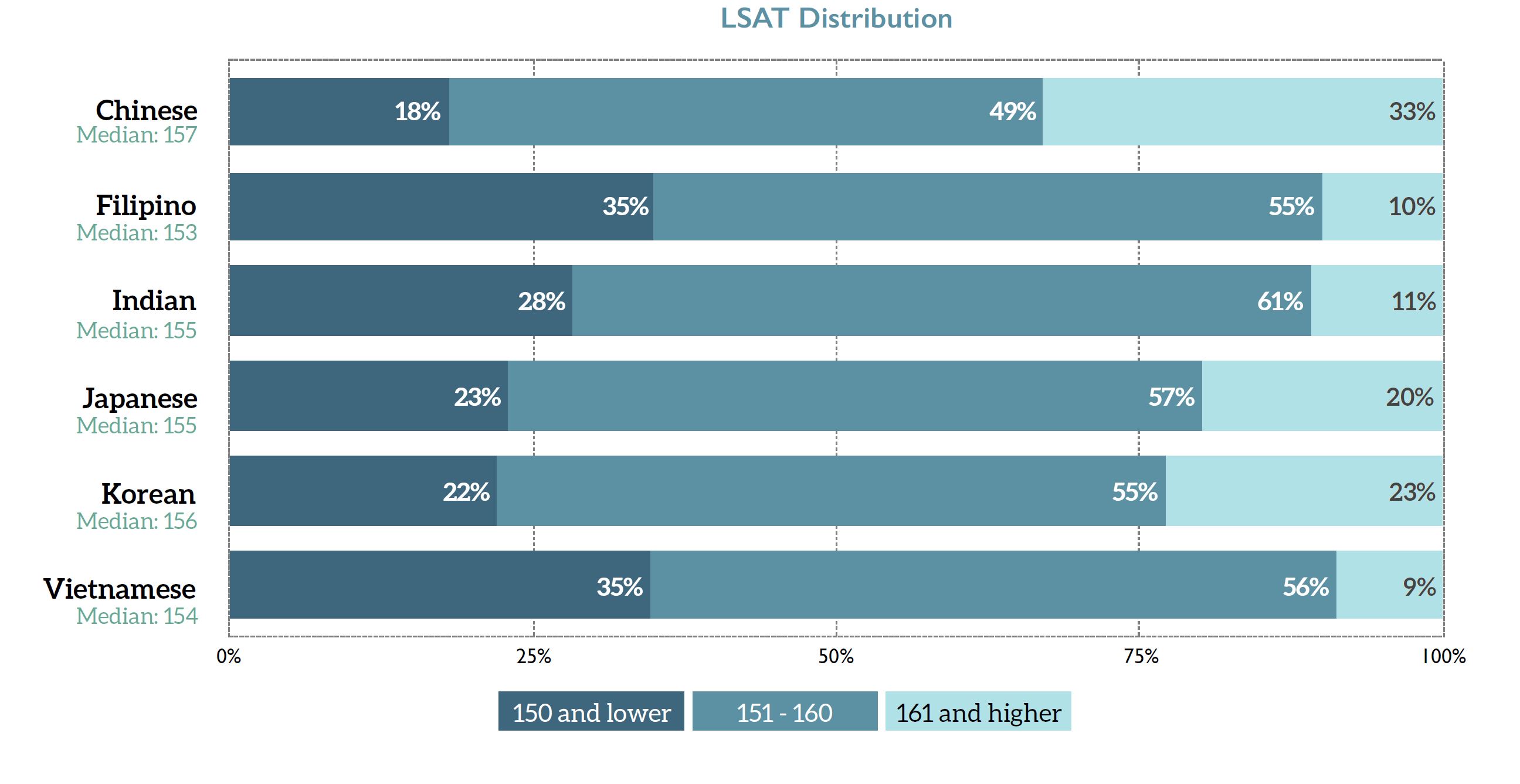
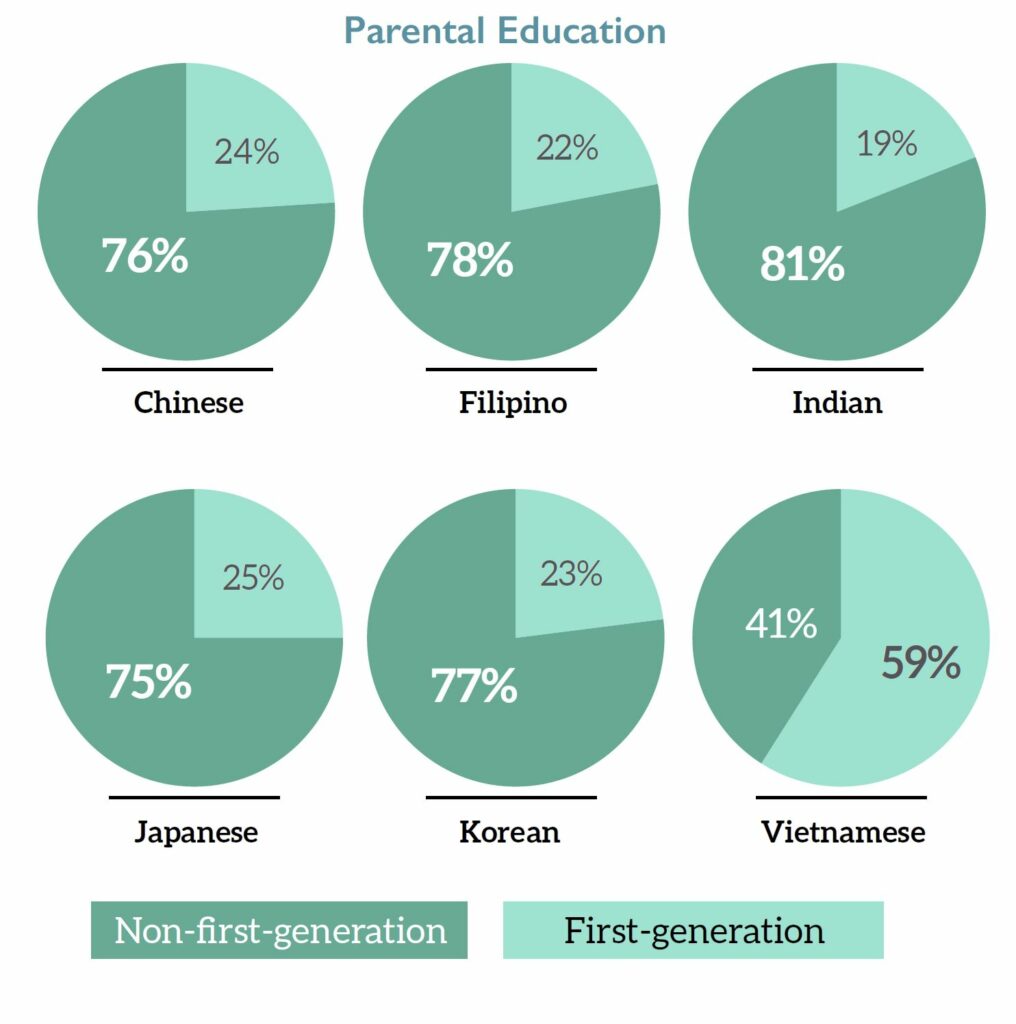
Law student debt expectation also varies significantly across ethnic subgroups. Only 15% of Chinese respondents expected to have more than $120,000 in debt after law school, compared with 51% of Filipino respondents and 44% of Vietnamese respondents. (The disparity could be explained in part by the prevalence of international students among certain respondent subgroups. 50% of Chinese respondents identified as international, while only 1% of Filipino students did. As LSSSE notes, international students are twice as likely to expect no law school debt than domestic students.)
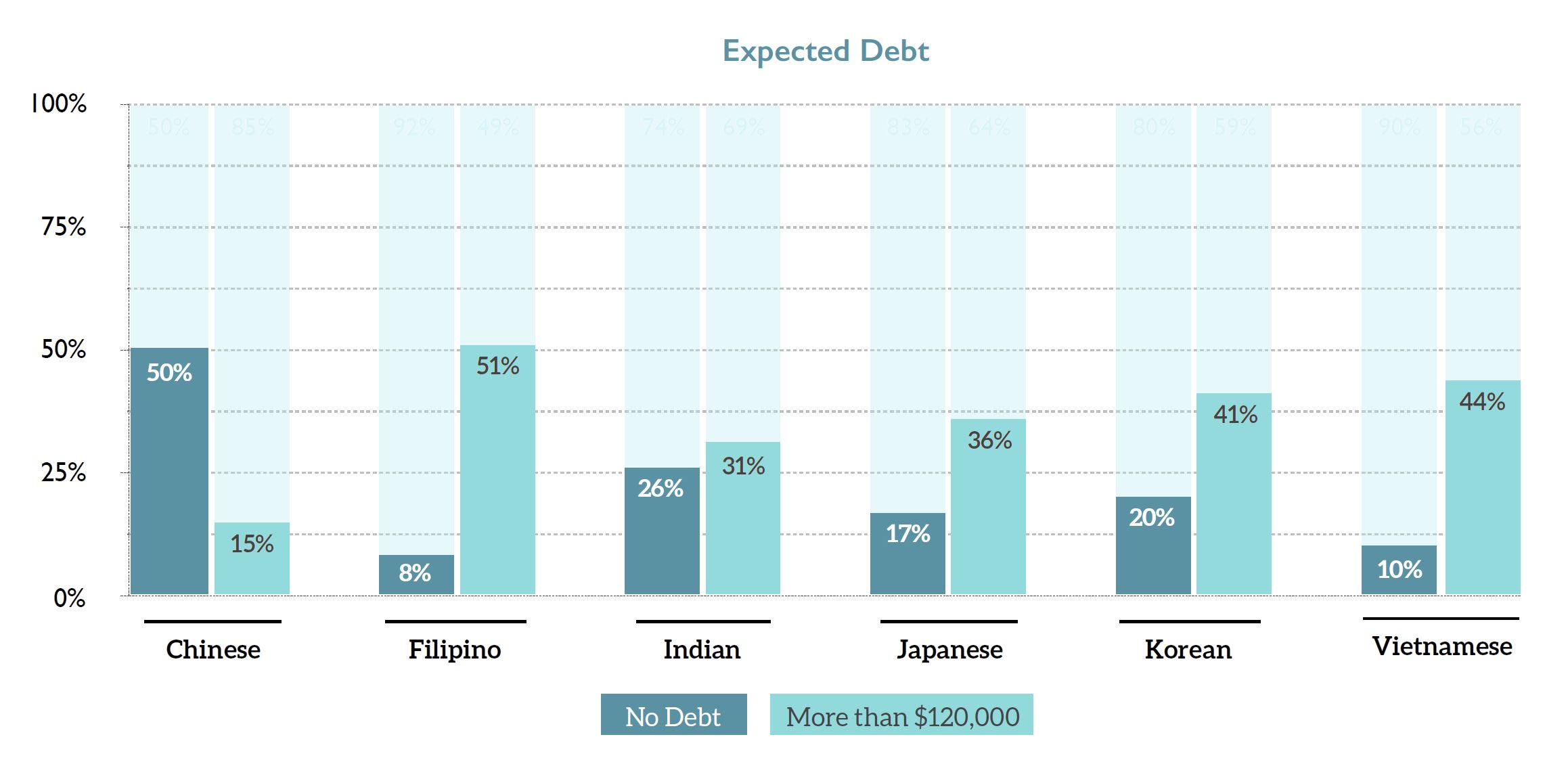
With regard to Asian American law students’ perceptions regarding law school support, Asian American law students generally do not feel they receive law school support to cope with non-academic responsibilities. Thirty-five percent of Chinese respondents and only 21% of Vietnamese respondents felt that support was provided.
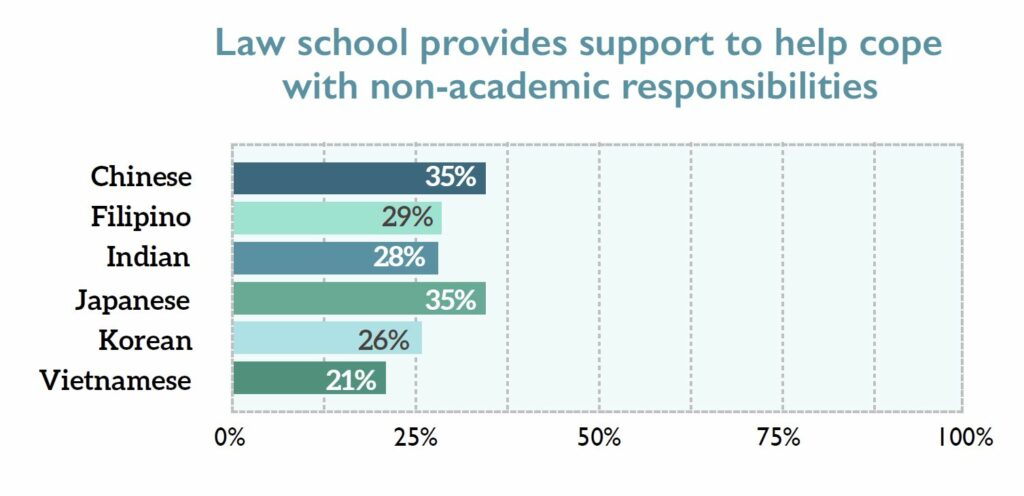
Given the LSSSE data, viewing Asian American law students as a monolith–as, for example, a group that finishes law school incurring little debt and that is a “model minority” with LSAT scores in the highest percentiles–would be a mistake. Doing so would miss the mark by a long shot in ensuring effective support of Asian American law students. Appreciating the diversity and broad scope of Asian American experiences is a prerequisite to pursuing equity and inclusion of all Asian American law students.
In our essay this Spring on inclusion of Asian American law faculty, we provided an aspirational checklist of self-assessment questions for law schools. We provide here a complementary list of self-assessment questions for law schools seeking to support Asian American law students.
- Are there Asian American deans, associate deans, or faculty at the law school that Asian American students can look to for support?
- Does the law school work to connect Asian American law students with Asian American mentors within and outside of the law school?
- Are Asian American students encouraged to pursue judicial clerkships and other government job opportunities?
- Are Asian American students receiving mentorship for leadership and being suggested for leadership positions and other recognition at the law school?
- Do Asian American students feel supported in their efforts to pursue law school studies while managing financial need and family care responsibilities?
- Is providing faculty support to Asian American students valued and does the institution acknowledge and account for this additional faculty work for supporting Asian American students?
- Does the curriculum include Asian American law courses, and is Korematsu v. U.S. taught in a mandatory course?
- Does the law school offer co-curricular activities, like journals, competition teams, or study-away programs, related to Asian American law?
- Has the impact of current events and law school policies on Asian American students been discussed and included as part of the work of the DEI committee or staff?
- Are Asian American students invited to participate on DEI and other law school committees and encouraged to advocate for themselves?
The Diversity within Diversity report is a laudable step towards documenting the vast diversity among Asian American law students. Disaggregating the data for Asian ethnic subgroups–done for the first time through this 2016 survey–helps to reveal the scope of this diversity and illustrates the need for more research about law students of Asian descent. On the occasion of Asian American and Pacific Islander Heritage Month, we urge law schools to share this data with their communities and engage in a self-assessment to identify areas that need attention.
____
[1] See Abby Budiman and Neil Ruiz, Key facts about Asian origin groups in the U.S., PEW RSCH CTR (Apr. 29, 2021), https://www.pewresearch.org/fact-tank/2021/04/29/key-facts-about-asian-origin-groups-in-the-u-s/.
[2] Id.
[3] Id.
[4] Id.
[5] Id.
[6] The term Asian American used in reference to law students described in the LSSSE data includes international students of Asian descent.
